#I live in Wales and there's a dragon on our flag
Text
Jess Watches // Sat 14 Oct
Synopses & Favourite Scenes
Our Flag Means Death
2x03
While the Revenge crew gleefully reunites under Zheng's reign, Stede attempts to bring back Blackbeard, who must face his own difficult truths.
Zheng and Auntie are my new favourite duo of the show. Zheng trying to seduce-threaten Olu. And Auntie being wise to everyone's bullshit. Also, the Jim/ Olu reunion was sweet. I'm okay with them being besties (with occasional benefits ofc).
Deadloch
1x07 Episode 7
Men start fleeing the town as more bodies are recovered and a shocking pact is revealed.
Abby get to show off her big brain and finally being appreciated for it surrounded by people who actually care about her. She was very correct to say James is a cunt multiple times too.
Supernatural Academy (with friend)
1x16 Fateful Part B (Season Finale)
Chaos ensues among the supernaturals as Elda releases the dragon-marked children to execute the ultimate demise; Mischa and Jessa risk their lives to fight Kristov and the East-West twins as the rise of the Dragon King is upon them.
The animation of the dragon king's wings being a glowing purple like they were designed specifically for me. Had literal heart eyes. I enjoyed this series so much I really hope it gets another season.
Rugby World Cup 2023
Quarter Finals
Wales (7) vs Argentina (8)
Blue 23 making that tackle in the corner against Rees-Zammit was amazing, and a game changer.
Ireland (1) vs New Zealand (4)
The most chaotic match so far. So much happening. I could feel my heart beating through those final phases. Not possible to pick a favourite moment when it was that intense.
#our flag means death#deadloch#supernatural academy#rugby#rugby world cup#rwc 2023#polls#tumblr polls#jess watches#day 25#new zealand#a kiwi heavy day#¡spuǝᴉɹɟ puɐlɐǝZ ʍǝN ʎɯ oʇ ollǝɥ
2 notes
·
View notes
Note
WHY have i just clocked that your username has baron in it as in baron zemo 😭. anyway, the newest chapter of ‘i get a kick out of you’…brb sobbing. you’re so so talented.
Yeah. Some friends helped me pick it. Zemo is my most popular character I've written for on here, so it had to be done!
The dragon bit is just because I live in Wales, and we have a dragon on our flag.

7 notes
·
View notes
Text
[ad_1]
Ask me what the best things to do in the UK are and I’ll always answer the same: immerse yourself in our culture. Perhaps you’re wondering what that means, seeing as a fair few memes say it’s only beige food and bizarrely titled royals. But having lived abroad for a few years now, I think I can finally answer that question based on all the bits of home I miss.
It’s proper pubs with banter, booze and slightly questionable carpets. It’s a cracking cultural scene that spans open-air theatres in the south to legendary live music and non-stop festivals in Edinburgh. It’s complaining about crappy countryside roads that squeeze through farmland before arriving at some of the world’s most spectacular coastal hikes. It’s wild camping on the outer Scottish islands where time stands still and stars dance, so you don’t mind the odd rain shower. And it’s lugging yourself into London on the train – while repeatedly complaining about the train prices to anyone who will listen – because there’s always another free museum to visit.
Not that we only have one culture – we’re four proud nations bound by one (often debated) union. Even city to city, you’ll notice the differences in accents, what we call a bread roll, and our signature slang. So, while it’s highly subjective, these are my picks of the United Kingdom’s top things to do – the ones I always suggest friends do when they visit to get a flavour of the country from top to toe. Sure, it might not list every single ‘must-see’ place in England, Wales, Northern Ireland or Scotland, but these UK experiences will introduce you to the country’s history, nature, pomp and people.
Tackle Wales’ Great Trails
Most first-time visitors to the UK rarely make it to Wales, and they’re missing a trick. Given my Gran’s Welsh, making me a quarter so, I’m proud to fly my little part of the coolest dragon-adorned flag there is. But if you venture to the wonderful west of Great Britain, get beyond Cardiff and into the unadulterated nature. Summit Eryri (Snowdonia) for sweeping vistas of lush peaks and dramatic, cerulean-hued lakes. If you’re lucky, you’ll see as far as Pembrokeshire, arguably the most handsome part of the whole country.
And it’s here, amongst the windswept, croissant-coloured beaches, that you’ll likely fall in love – especially if you come in spring when the Wales Coast Path is lined with fluttering vivid wildflowers. Whether it’s along the border-tracking Dyke Path or the craggy coastal trail, Wales’ Great Trails offer some of the UK’s best self-guided adventures on foot or bike. En route, I guarantee you’ll stumble upon so many beautiful off-the-beaten-path spots as you traverse across scrub, shores, moors and all-smiling remote villages that you might just forget about the other three nations.
Fossil hunting on Charmouth beach is one of the UK’s best activities
Fossil hunt on a South Coast road trip
I might be biassed as this is my home region, but little can compare to the southwest of England, specifically the history-hiding Jurassic Coast. Not that it hides its history that much. You can actually hunt out fossils buried just below the surface of these gorgeous sands. One of my favourite things to do in the UK even now is to take a road trip along Dorset’s Jurassic Coast and search for ammonites and belemnites that are millions of years old. Pop into one of the museums along this 95-mile-long stretch of shore, and you’ll be stunned by some of the dinosaur fossils people have actually found and put on display for all to see.
I’d love to tell you to book a little beach hut and Lyme Regis and chill out for a while. But these days, getting one of those aquamarine seaside huts is nearly as impossible as meeting one of the stegosaurus that were here long before sunbathers. Instead, rent a car and work your way down the coast from Dorset to Devon. Start in my hometown of Bournemouth, skate along to the dramatic rock arch of Durdle Door – don’t
miss the Man O’ War Beach next door, it’s the best – and then continue on to Charmouth to find your own piece of history. Along the way you’ll learn all about Mary Anning, one of our most prolific dinosaur fossil hunters, enjoy top-notch fish and chips in seaside pubs, and then cross into equally as handsome Devon for the final stretch. Summer might have the nicest weather, but it will also have half of London on the shores. Come in late spring or early autumn for the best experience.
Paying a visit to the Roman Baths is one of the best experiences the UK has to offer
Discover the UK’s Roman history
It’s not that I don’t think Stonehenge — our most famous prehistoric megalith – is impressive or fascinating. But if you ask me what the UK’s top historical experiences is, I’m going to point you in another direction: Roman Britain. For me, the 350-odd years we were part of the Roman Empire is a far more interesting part of our country’s story. Even these days, we’re still discovering new parts of this historic chapter, such as the new London museum showing off a recently discovered part of a former Roman Wall at Vine Street or the well-preserved mosaic found near the Shard. But it gets even better than that.
Start your history tracing in the city of Bath, at the impressive Roman bathing complex that has been in the heart of the city since 70 AD. Then, cross over into Kent to tour the Lullingstone Roman Villa (currently under renovation) and marvel at the well-preserved wall paintings and mosaics. Heading north, the Wroxeter Roman City is an open-air walk back in time, while Hadrian’s Wall, further still, is perhaps the best Roman sight of all to visit. Stretching across the width of the country, you can track the weathered Roman fortification wall across remains of forts and towns. Once, I was there for an epic evening when they illuminated the whole wall with torchlight, and it was incredible, though it apparently only happens once a decade. Regardless, it’s an excellent place to start your introduction to Roman history, before continuing on to bonnie Scotland.
Why not sleep in Durham Castle to upgrade your UK experience?
Sleep in a castle
We may be the country of outdated pomp and funny royal titles, but that’s given us plenty of practice at perfecting castles. Sure, visiting Windsor or Edinburgh Castle are cool things to do, but if you’re looking for the best castle-related activity in the UK, it’s got to be sleeping in one. In fact, you might be surprised to learn that castles are apparently so commonplace in this old land that students even use them for dorms. Yes, really! I couldn’t believe it either when I was touring Durham Castle — a Harry Potter filming set — and I was told that the University students slept there. During the summer holidays, it becomes one of the UK’s most unique hotels. And it’s far from the only option.
All across the land, you can splash out and splurge on a stay in a British castle, which has got to earn some kind of bragging rights – especially if you rent a private one for you and your travel crew. Why not go wild and rent out the 1,900 acre estate of Crom Castle in Northern Ireland, or 18th-century Birkhill Castle in Scotland. Or perhaps you’d prefer to while away some days in Wales’ haunted Craig-y-Nos Castle? Either way, a regal stay is in sight on our shores.
From scenic rail to serene lochs, the Scottish Highlands have it all
Ride and hide in Scotland’s highlands
Call me a traitor to England all you want, but Scotland can’t be beaten. Yeah, the weather might be worse more often than down south, but any chance I got to be in Scotland, I took, whether it was bar work in Glasgow or spending the month of August working at the non-stop Edinburgh Festivals. After those late-night work trips, I’d always slip away into the Scottish highlands for some R&R, and I highly recommend you do the same on your Scotland road trip. Sure, take the “Harry Potter” Jacobite train, it really is spectacular,
and do a loop of gorgeous Skye – avoiding summer when over-tourism doesn’t even cover it – but then come back into the gorgeous glens (valleys), munro (high mountains), and legendary lochs (lakes) flanked by crumbling castles.
Out here in the hypnotic highlands, time really does seem to slow down if you’ll let it. Sure, you can get busy summiting Ben Nevis, the UK’s highest mountain, or trying to spot the mythical Nessy Monster with your own eyes, but it’s also equally enchanting cycling through Glen Coe, made famous by 007, or wild camping alongside a wild-flower flanked lake. Not a fan of camping? Spending a few nights at Eagle Brae Cabins, one of Scotland’s unique stays, is my top tip of things to do in the UK for a proper bolthole escape. Especially as these homely log cabins with photogenic turf roofs are set on a private landscape with deep and adorable goats trotting around. Pour yourself a dram of whisky (without the e up here) from the Isle of Arran, sit out on your terrace, and be entranced by absolute bliss.
Start a night in Manchester at Mackie Mayor for good grub before going until the early hours
Make it an all-nighter
There are a fair few jokes about British drinking culture (more on that later), which, I think, are mainly warranted. But if you really want to see the best of Britain, you’re gonna need to have at least one proper night out. Luckily, the best nightlife experiences in the UK span the whole country. From Belfast’s chummy and craic-filled Irish pubs soundtracked by traditional live music to the LGBTQ+ bars of free-spirited Brighton in the south of England, there really is a non-stop night out for all.
Liverpool, with its legendary musical credentials courtesy of The Beatles, won’t let you go to bed early. Manchester is a cracking city for a night on the tiles, whether at the gay bars of Canal Street or raving to pumping Techno at The Warehouse Project. Up in Glasgow, a UNESCO City of Music, I’ve had some of the absolute best and wildest nights of my life – Scottish people are the best people to make drinking buddies with. And, of course, in London and Edinburgh, you’re just as spoilt for choice. After dark, we Brits somehow seem to be at our best – just apologies for any chundering, scraps and the state of some kebab shops!
Ride vintage trams, play dress up, and visit recreations of Victorian kitchens at Beamish
Go back in time at Beamish
One thing the UK excels at is museums, and I’m not just talking about your average quick walk through some information boards. Take the Beamish Living Museum of the North in Durham, perhaps the best museum I’ve ever visited. Here, a whole set of interactive villages have been built to show what life was like at various stages throughout Britain’s history. From sweet shops to moving trams and photo studios to interactive classrooms, actors and the re-constructed properties literally transport you to times gone by – hopefully, they can open safely this summer.
There are multiple museums like this in the UK, from the Cosmeston Medieval Village in Wales to the Blists Hill Victorian Town in Shropshire, and including one of these in your next British getaway will add another level of history to your UK experience.
Have a proper fish and chip takeaway or get it down the pub to experience the UK’s boozers
Pies, pints and fish and chips
What’s a good night in the UK? Well, it might look something like this… It’s dropping clangers during a chinwag in a bee’s knees boozer that’s chockablock with sloshed chavs while complaining what a cock up things are to any geezer who will listen because it’s all gone pear-shaped. Then, it’s a cor blimey to the publican about how many quid a pint costs (he’s taking you for a mug) before noshing on a cheeky Nandos. But you’re cream crackered after, so you pinch one last fag and skip the knees up to leg it to your gaff for a kip so you’ll be full of beans tomorrow as you don’t want to make a dog’s dinner out of the Sunday roast, innit. Confused? You’ll have it nailed after a few nights down your temporary local!
Nothing can beat the British pub for an evening out. I’ve been lucky enough to travel and live in so many countries now but the good old British Pub is an institution that can’t be rivaled (alright, Ireland, I’ll tip my hat to you, too).
[ad_2]
Source link
0 notes
Text
I see a lot of American cryptids and mythical creatures on here, so I thought I'd share some of my favourite creatures from here in Wales! 🏴
Afanc
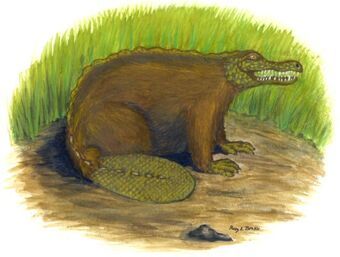
A crocodile and beaver type creature. It lives in welsh lakes, and sometimes Conwy river. It's a demonic creature that eats anyone who swims in its home.
Ceffyl Dwr
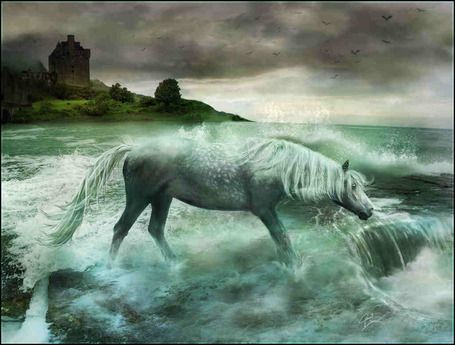
Similar to the Scottish kelpie. It inhabits mountain pools and waterfalls. North wales lore says it's quite evil and foreboding, whereas south wales lore says it's quite a friendly creature. I'm north Walian so this is our version: It entices people to ride it and then evaporates mid air, so the rider falls to his death.
Llamhygin Y Dwr
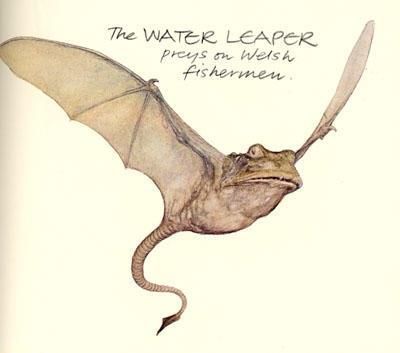
The Water Leaper. It's a bat/frog/lizard hybrid. It lives in lakes and ponds, snapping fisherman's lines and eats livestock and fishermen.
Y Ddraig

The famous welsh dragon, featured on our flag. Legend says that Vortigen wanted to build a castle right where 2 dragons were said to be sleeping. When they started digging, they found 2 dragons fighting, one white and one red. The red dragon won.
Gwillgi
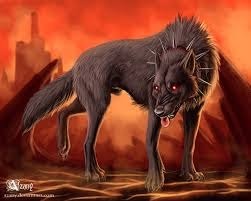
Similar to the English black shuck, gwillgi is a fearsome black dog who haunts rural welsh roads at night.
Coblynau
edit: I have deleted the photo due to the antisemitic depiction of y coblynau.
Gnome like fairy creatures, they live in Welsh mines. They help the miners find the rich veins of ore and other treasures by knocking.
Cyhyraeth

Similar to the Irish Bean Sidhe, y cyhyraeth is a disembodied moaning voice that foretells death.
Cath Palug

Palugs cat was an enormous cat that lived on Anglesey. It killed 180 warriors who were sent to kill it.
Adar Llwch Gwin
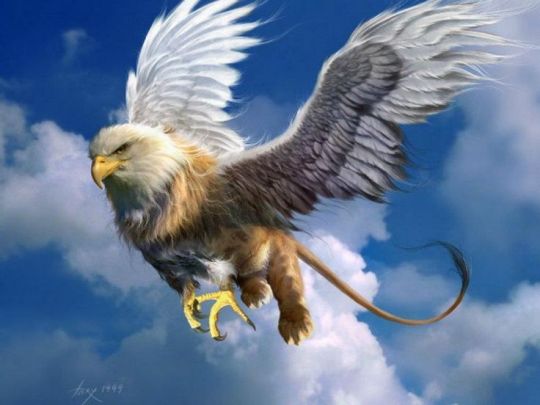
Griffin type creatures that were gifted to Drudwas ap Tryffin by his faerie wife. They understand human language and obey commands.
Cadair Idris

Translates to "Chair of Idris". Idris was a huge giant and this mountain was his chair. Legend has it that if you sleep on this mountain, you'll either wake a madman or never wake at all. I've actually been here, it's not far from my house.
Hope you enjoyed these few creatures from Wales!!🏴
#welsh#welsh folklore#welsh mythology#mythology#british mythology#cryptids#mythical animals#mythical creatures#angie talks#cryptid
6K notes
·
View notes
Note
Hello! I just saw your post about how ppl wearing/displaying their flag if they’re American/Australian/English probably means they’re a racist and I 100% agree. I really appreciate your takes, so I wanted to get your opinion on how this applies to a country like Wales where the legacy is different? Do you still think these implications would apply, or how might they be change?
Ooh, good question! I'm slightly Christmas Drunk answering so let's find out together how coherent this is.
So the big thing with what I'm going to call "flag culture" for the purposes of this conversation (the social application of Your Flag TM to clothing, products, or general display) is that the flag itself obviously means nothing - it's just colours and shapes, even if you're Welsh and lucky and one of those shapes is a fucken sick dragon. But a flag is a symbol, and that's the crux of the issue.
What is it symbolising?
And, therefore, why are you choosing to display that symbol?
In fact, I don't automatically think it's a Bad Thing, per se. I think nationality is not actually a bad thing inherently. Human beings are social. We're designed to live socially, and communally, and to be enriched by shared experiences. On a large scale, that's what culture is, really, when you get right down to it - the official definition might be "a shared set of norms and values", but in real terms it's "do we have this shit in common?" And nationality is just a big version of that. It gives people a sense of belonging, and community, and therefore safety, because we're hard-wired to want that.
Flag culture is an extention of that. It's an expression of community, and belonging. So far, so benign.
Here's the problem: what is the community? What actually is the shared culture of that community? What is being celebrated? Why are the adherents celebrating it?
In the case of that particular post, we were talking about how seeing Americans plastering the US flag about is a sure-fire sign of a racist, and ditto Australia and England/Britain. I'm none of those, really, but I can make a claim to being British I guess, if not English, so that's the one I'm going to zero in on here.
Britain suffers from a lack of clear culture of its own, because England conquered almost the entire world and took whichever parts it wanted. When the dust settled, not only did they have a sort of jigsaw of cultural things that were blatantly taken from elsewhere, but they'd also spread even that about so it was no longer unique to them. Mainstream English culture has very little now to hold up as their own. In Wales, I can gleefully talk about the Mari Lwyd, and Eisteddfods, and calennig, and the Mabinogi, and the Royal Welsh Show, and a whole bunch of other things. But England doesn't really have that, and they can't see Mainstream Western Culture as theirs or as special because... it's everywhere. They live in it. It's not unique to them. They can't show off about it, and they can't feel any sense of belonging and identity from it.
(Side note: the tragedy is that there's actually plenty they *could* use, that's English and Not Blatantly Stolen. Off the top of my head: Morris dancing, folklore like black dogs, football (without the cunts), customs like First Footing, Robin Hood, NOT FUCKING ARTHUR HE'S WELSH AND HE'S OURS HANDS OFF etc)
So, what do you fall back on instead?
Nothing good. "We conquered everyone!!! YEAH!!! ENG-GER-LAND, ENG-GER-LAND, ENG-GER-LAND!!!"
Community becomes about anything you can. "You look wrong. You have the wrong God. You dress the wrong way. You speak the wrong language. You don't belong in our gang."
And so, the racists! The flag becomes a symbol of both imperialist conquest AND thundering bastards with no personal hygiene.
But, if your country has its own visible and identifiable culture AND a history of being actively oppressed, then the sense of belonging, the urge to be a community, the need to have a shared culture and feeling of safety is a bit different.
Under those circumstances, plastering your flag on a shirt is not an act of oppression, or rejection. It's an act of defiance against an outside force that wants to erase you. "You want my culture to vanish? Not so fucking easy, sunshine, it is right here."
That is absolutely not to say that a small oppressed minority is incapable of using flag culture to be a big old pack of racists, nor that every use of large Western nations' flags is automatically racist, of course. We're talking about overall trends here, that's all.
Ha, okay, I reckon the difference could arguably be pared down to "This is who I am" vs "This is who you aren't". If I see someone wearing a dragon they're telling me who they are. If I see someone in a St George's Cross they're telling me that I don't belong, and also, that they have superiority.
Anyway I'm, like, eight Baileys deep, so I hope that made sense.
61 notes
·
View notes
Text
Australian State Flags rated
Vexillology is a subject that, like many others, I have a passing interest in. Very passing. Look I occasionally browse r/vexillologycirclejerk, the One Good Subreddit, because they have some very fresh and funky memes.

One thing I do know about vexillology and flags in general is that nobody ever actually looks at state/provincial flags, and that as a result there’s a bunch of weird ones hanging about. I’m sure this is even more true of Australia, seeing as we have many less people to care about our many fewer state flags.
So for today, I’ve decided to shine a light on some state flags and see if they’re any good. Spoilers: they probably aren’t great? (Edit: they’re also largely very very similar, oops!)

New South Wales- in keeping with the name, New South Wales apparently has decided its flag should be fairly Welsh as well. Except not, because the image on that one is a cool dragon instead of this random lion, and the red cross is actually an English thing. This is extremely lame! The placement of the O R B is also pretty awkward and uneven, leaving a whole bunch of blank space that’s just. Blue. It’s centred if you just look at the right half, but it looks weird next to the Union Jack.
I don’t like the Union Jack. Get used to seeing the Union Jack a lot. 1/5.

Queensland- Okay, so, we took the NSW one, took the lion and the cross off it, and put a nice little crown on because, you know, Queen. While this is somewhat less ugly than the lion, it is also less cool, because fuck the royalty. Add in the cyan not contrasting well with the darker blue (imo) and you have a recipe for another not good flag. 1/5.

South Australia- Well now we’re getting somewhere. Take the previous two, get rid of the shit designs in the circles and replace them with an extremely good bird. Look at that plumage, that dramatic posing! What a good. That, and orange (its supposed to be gold I think, but come on) is a good colour to go next to navy. Unfortunately, it’s still sitting next to the fucking Union Jack, so it’s not going to be that good. Fuck colonialism, 3/5.

Tasmania- Wait ok so this is just a lion again, but if the lion was drawn by the same person that did the welsh dragon. It’s a lot less busy without some nonce cross in there (save Jack in the corner), which is great, but Bri’ish lion flag designs never look good to me. You want your iconography to be simple but striking, in my opinion, but whenever they put a lion on there it has to have too many details to communicate “lion” that it just looks super mid. 2/5.
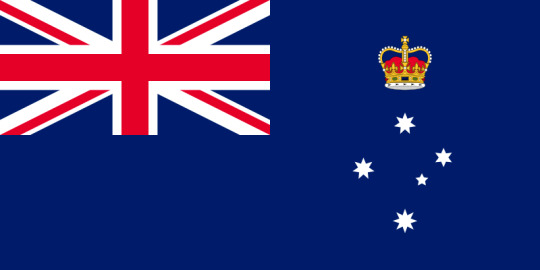
Victoria- of the many, many places on this Earth named after Queen Victoria, this state sure is one of them. We’ve dropped the circle motif for this one, which is nice, but the crown is still fucking there. This is literally just, we took the country flag, and replaced that cool star with a lame crown. Somehow this is Dan Andrews’ fault. 2/5

Western Australia- I’m obviously biased, but it’s a very good little swan we have there. Black swans are iconic of Perth, there’s many, many of them on the Swan River (funnily enough), and they’re common enough that it’s not hard to spot one of them doing something gnarly and immediately ruin all majesty they ever had for you. In my case, it was when one of them looked like it was preening, or at least sleeping with its head tucked in its wing, for a few minutes before dropping a deuce and buggering off.
But I digress. It’s also on a gold background, representative of the intense sunlight that we live with in WA. It would be great if just the right half of this flag was the whole of it, but unfortunately, lmao Union Jack. 3/5.

Australian Capital Territory- What you thought we were done? Come on now. There’s like, 2 internal territories and 3 external ones still to go.
With the states behind us, we get to say goodbye to Jack as well. He shall not be missed. Uuuunfortunately, while we do get the classic Southern Cross, we also get this ridiculously busy design on the right. These swans are so mad, and why are they standing like that? Why is one of them white? Why is there a fucking castle here, we don’t have those? The mind boggles. 2/5.
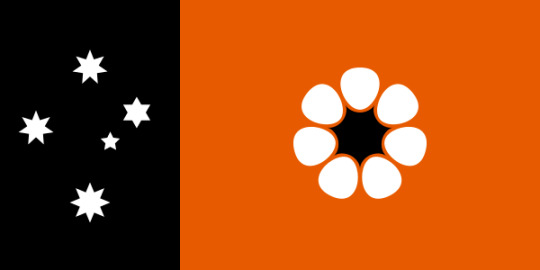
Northern Territory- Oh, that’s much better. The southern cross ditches the bluey background for the much more accurate pitch black of space, which contrasts great against the ruddy brown of the desert the Territory largely is. The flower is simple, but elegant, and uses the same colours as the left third which I appreciate. This is just a good, solid flag. 4/5.

Christmas Island- For as much as Australia gets associated with the “green and gold”, I’m surprised it took this long for that colouration to actually show up on the livery. I’m not a huge fan of, just, the map of the place on the flag for the place, and Green/Gold and Blue/White aren’t a great colour combo. But there is a very good bird here. 3/5.

Cocos Islands- Yo that’s the crescent from the Malaysian flag, huh? Yeah so apparently the history of this place is kinda fucked (Australian history, bad? Nooooooo….), but the residents are largely Malay descendants, so fair enough. As far as the flag goes, it’s an interesting mix of iconography that is largely fine apart from the absolutely terrible looking palm tree on the left there. That’s some 2002 clip-art shit right there. I actually like the right 2/3rds of this, so just… remove the left third. Actually I think most of these flags would be significantly improved by the removal of the left bit. 3/5.

Norfolk Island- It’s just a tree, dude. 4/5.
Well that’s all of them. Ultimately, most of these were bad, and none of them were actually, like, great. That’s kind of just state flags for you, though. I’m no expert vexillologist, but there are only a couple flags that have truly caught my eye, and none of these fit that bill.
We have a lot of stinkers, and tragically, nothing nearly stands out like some other countries get their state flags to do. As a final note to leave this on, and to prove my point, I’m going to present the flag of the Isle of Man.

Fucking Brits actually have a good one. Can we get this instead of the Union Jack, please? Thanks.
#ramble#australia#vexillology#state flag#the indigenous one isnt on here because honestly it should just be in all of them in place of the UJ
8 notes
·
View notes
Text
The Welsh Red Dragon, Kurt Vonnegut, and Social Activism
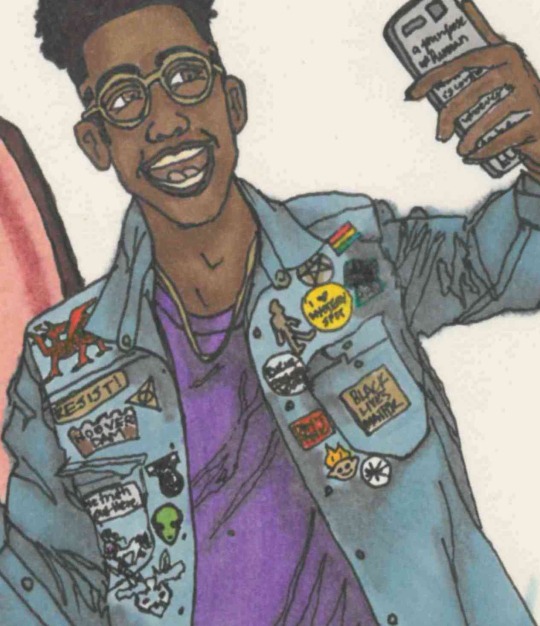
The inspiration behind Shepard’s pins
(original post with full artwork here.)
So, I spent A LOT of time thinking about the kind of pins our good friend Shepard (from Omaha, NE) would have on his denim jacket. Like a lot. Like an obsessive amount of time. I made a list, which seemed appropriate for this fandom. And because I’m a nerd and this sort of thing really interests me, and I’m proud of what I came up with, and because I think some of these items open up the possibility for some good, good literary analysis, I decided to make a whole post dedicated to Shepard’s pins. You’re welcome.
First, a little bit about my thought process. How did I decide what kind of pins to give Shepard? Well, he’s a guy full of stories. Stories that he can’t wait to tell anyone and everyone. And stories that others (mostly Maybes) have told him, once he’s earned their confidence. So, I wanted his pins to tell a story, his story in particular. What is the story that Shepard wants to tell about himself? More precisely, what is the story he wants to tell his new magickal friends on a disastrous summer holiday? The story is that of his own magickal credibility. His journey to magic (his come to Crowley moment, perhaps?) (I’d apologize, but I’m not sorry…) and his trustworthiness as evidenced by all of the Maybes he’s met along the way. He’s gotten drunk off dandelion wine with a creek dryad, given a toothbrush to a Sasquatch. spilled the tea with a jackalope, midwifed a centaur foal. Shep’s journey is just as impressive as Simon’s, and while Simon has been collecting notches on his dead dark creature bedpost (that’s a weird fucking metaphor…) (and now I’m thinking about dark creatures and Simon’s bedposts…so, you’re welcome, Basilton), Shep’s been collecting notches of the friendly variety. (Shoutout to @adamarks who did some super lovely analysis on Simon and Shep as mirrors here: https://adamarks.tumblr.com/post/188046272067/ok-so-when-shepard-said-he-was-cursed-the-first). So, I decided that I wanted to use Shep’s pins as a way to show the notches on his bedpost, so to speak. (Okay, I’m really losing this metaphor, but I think you’re still with me.)
Let’s dive in!
(I’m working my way down one side of his jacket at a time, for those following along at home.)
RIGHT SIDE
Welsh Dragon:
I made this one very large, and easy to spot on his right shoulder. Of all of his accoutrements, this one felt like the most important. Mainly, because of Simon. Simon is, after all, half-Welsh. (The Mage, may he rest in pain, came to Watford from Wales.) And, of course, Simon, just like the Welsh Dragon, is a red dragon. (Or in the process of becoming one? Or a half-dragon? Or a dragon kitten?…) And the dragon that Simon and Baz fought on the Watford lawn, when they first worked together, and first shared magic, was a red dragon. Of course, the actual dragon in question here is Margaret. Shepard would absolutely have a pin to commemorate his friendship with her. And since I was going to give him a pin with a dragon, I knew I was going to have to use the Welsh Dragon because it would perfectly capture his burgeoning friendship with Simon, as well. Now, I want to go on a slight detour here (this blog post will be its own Odyssey) and talk more about the Welsh Red Dragon. I took the design for the pin from the Welsh flag, which is the thing that first made me think more about Simon’s Welsh connection. I’m not really making a point here, I just think it’s fascinating! There’s a lot of Welsh lore about the Red Dragon (and Margaret herself calls Simon “Great Red” - that ‘R’ is capitalized, by the way, so this seems to be a proper name for the kind of dragon that she thinks Simon is). Full disclosure, I am not Welsh and I am not a scholar on any of this by any means. That being said, a cursory, and super academic, perusal of the Wikipedia article on the Welsh Dragon led me to a few different history websites that linked the symbol of the red dragon with Merlin and King Arthur (son of Uther Pendragon, literally dragon head). Merlin, one of the most well-known magical figures and Arthur, one of the most well-known Chosen One figures in literary tradition. I know very little about Arthurian legend, and Welsh history, and dragon lore, though, so I’m going to just say, do a little research on your own when you’re bored and feeling nerdy!
Resist!:
Shep is a young black man (and reasonable human being) living in the U.S. during the [redacted] Administration. I should hope this one is self-explanatory.
Hoover Dam:
At some point in his visits to see Blue, I’m sure Shepard stopped off at the gift shop and bought himself a souvenir pin to mark the incredible experience he had making friends with an actual river. (This pin design is based on an actual souvenir pin of the Hoover Dam I found on Google Images—along with most of the other pin designs. I think it’s vintage, which just felt even more like Shepard to me, because he’s the kind of guy who would appreciate stuff that’s got a past.)
Deathly Hallows:
I mean, IF the Harry Potter books/movies exist in the Simon Snow universe (which hasn’t been confirmed, as far as I know, by our Queen) I’m sure Shepard would have been totally into it as a kid, and probably would have found greater significance in its magical lore once he discovered that ACTUAL MAGIC EXISTS! So, he would have a pin to show his belief in the magickal world, and maybe also as a nostalgic reminder of when magic was still just something fictional he could turn to for escapism (and not something that would result in being cursed by a demon…).
The Truth is Out There:
So, I know virtually nothing about The X-Files (my sister was obsessed with it to the point that she wanted to become a FBI agent for a few years, but I never watched it), but I’m sure Shepard is a fan. If nothing else, the sentiment is awfully apropos.
So It Goes:
This one is very hard to see. It sort of looks like a black teardrop with a bar on top of it (it’s supposed to look like a bomb). The pin I based this off of reads “So It Goes”, which from my very superficial research, is a line repeated in Vonnegut’s anti-war novel Slaughterhouse-Five every time someone dies. I don’t know anything more about it, other than that it is a Kurt Vonnegut-inspired pin available for purchase on Etsy, and Shep mentions that he wanted to get a Vonnegut quote tattoo, even though “everybody has those.”
Green Alien Head:
You will never be able to convince me that Shepard does not 10,000% believe in the existence of aliens. If he were still in the U.S. during the Area 51 Raid, I’m sure he would have stopped by, just, you know, for science…(I’m thinking he was probably still in the UK, but I guess we’ll see in AWTWB.)
Centaur:
This one is also hard to see, but I took the design from a pin I found of one of the centaurs (the blue-haired, blue-bodied one, if that rings a bell for you) from Disney’s Fantasia. (Fun fact: I was super into Fantasia as a littlun, and I attribute my lifelong love for classical music in large part to the centaur sequence and my latent lesbianism—I mean, it was ludicrously erotic. Watch it sometime and tell me it would not make an impression on a sapphic three-year-old.) Midwifing a centaur foal was probably a very emotional and formative experience for Shepard. Buying this pin would be his way of remembering that experience, and the excitement and gratitude he likely felt to have been entrusted with that kind of acceptance from the centaur(s).
Jackalope:
It doesn’t help that this pin is almost the same color as Shepard’s jacket, but it’s based off a design of a jackalope’s head that, again, I found on Google Image search (honestly, I don’t know how I ever made art without it). We know that Shepard once got some gossip from a jackalope, who vented to him about magicians calling “themselves ‘magicians’”, like “they’re the only ones with magic”. (This is totally irrelevant, but I always think of Americans when I read this. I am an American, by the way. America is a continent, but those of us living in the U.S. calls ourselves Americans, like everyone else living in America doesn’t matter.) Anyway, the jackalope offered Shepard some valuable insight into the political workings of the magickal world, so it gets its own pin.
LEFT SIDE
Pansexual Pride Flag Pin:
I mean, technically, canonically, we don’t know what Shepard’s sexuality (or asexuality) is, but I just get some vibes from him. Plus, if we take him as a mirror for Simon (who is somewhere on the bi-plus spectrum), it’s not a far cry to imagine he also identifies somewhere on that spectrum.
Pentagram:
This is another symbol that I chose based on my interpretation of Shepard’s character, and not so much on a Maybe or a story that he mentioned. The pentagram, or pentacle, is typically associated with the occult and witchcraft, which is something that could potentially also be said of Shep.
Sasquatch:
You don’t go backpacking—or not backpacking—and introduce a Sasquatch to the benefits of dental hygiene without getting yourself a souvenir of the hike.
I [heart] Mystery Spot:
The Mystery Spot is a weird sort of phenomenon in California (my home state). It’s a place outside the beach town of Santa Cruz that boasts of a “gravitational anomaly” on its website. I went once, years ago, and while you’re there, it can feel pretty convincing. (Also, I was probably like 10, so…) People outside of California will likely never have heard of this place, but driving around here (at least in the Bay Area, where I am, which isn’t that far from Santa Cruz) you’ll see yellow Mystery Spot bumper stickers on cars everywhere. I’m not really sure what the thing is with the bumper stickers. Like, I’m sure not that many people actually think it’s legit, and maybe it’s like one of those things that Californians just do (like freak out and forget how to drive when we feel water falling from the sky). But yeah, these bumper stickers are everywhere. Anyway, Shepard drives around a lot. He knows about the Vampires of Las Vegas (how is that not an indie rock band?) and the Katherine Hotel, and the Next Blood. So, he’s probably made it past Nevada and into California before. And while he was there, it’s not a great stretch of the imagination that someone who chases after magic wouldn’t wind up at a place called the Mystery Spot and get himself a pin while he was there. (And maybe even a bumper sticker.)
Black Power Fist:
Unfortunately, this one is also hard to see, because the fist is black and I didn’t have anything to go over the outlines of the fingers with, which I sort of didn’t think about when I colored it. This one also feels self-explanatory. Shepard is black. Blackness has long been treated in itself as a crime by non-black members of law enforcement, and just the general racist population of the U.S. Young black men are especially vulnerable to racially motivated violence. I’m sure Shep, who drives all over the country by himself and gets into high speed chases at night in the middle of nowhere Nebraska while hunting super shifty rando Maybes has had a run-in or two. Stay safe, Shep!
Every Pronoun Belongs Here [Trans Pride Flag background]:
Also, super hard to see because the letters are too small to read. I found this exact pin in a basket by the register at my local bookshop. (Support local bookshops, people!) They were being sold as a fundraiser for a LGBTQ club at one of the high schools, and I loved the idea that I could help them raise money and add this pin to my own growing collection to show off my support for trans rights. (Support trans rights and trans people, people!) I decided to give Shepard this same pin, because I could imagine him having an almost identical book buying experience in a dozen other towns that he’s probably visited. And I love the simplicity of the message, because it’s one of belonging, which EVERYONE is desperately seeking, no matter who they are or how they identify, and Shepard, and every character in this picture, is no exception. (Plus, it seemed like a cool way to connect my pin collection with Shep’s. Maybe I should have mentioned the fact that I’m also a pin person at the beginning? I walk to work and on my lunch breaks, so I carry all of my stuff in a backpack. And I proudly display my random pin collection on my backpack. Including several Simon Snow-related pins.)
Don’t Panic:
This was based off a Hitchhiker’s Guide to the Galaxy pin. I don’t really know anything about the Hitchhiker’s Guide to the Galaxy (including if it’s okay to abbreviate it as HGG? THGTTG? whatever), even though I did watch the movie years back when it was on TV and I still lived with my parents who had a TV. But the sentiment felt appropriate, and Shepard is a sort of magickal hitchhiker. Apart from managing to hold down a job at Dick Blick, he appears to lead a somewhat nomadic lifestyle. He tells Penny, “the road is my teacher”, and if that’s not a hitchhiker slogan, I don’t know what is. (Ass, gas, or grass?)
Black Lives Matter:
They do. Just sayin’.
Magic Troll Doll:
When I was growing up, the Troll doll was all the (nightmare-inducing) rage. Trolls are one of those magickal creatures that are continually mentioned in the series. Shepard talks about lonely trolls under bridges. Simon talks about killing trolls. Agatha would rather kiss a troll. And Baz was kidnapped by numpties, who are sort of like trolls. I couldn’t not include a troll. And the Troll doll specifically felt perfect, because the full name was Magic Troll Doll. You can bet if Shepard had to pick a troll-related pin, it would be a magic(k)al one.
[Asshole]:
This is another Kurt Vonnegut pin. It looks like a messily drawn asterisk (*), but it’s actually meant to be an asshole (taken from the preface of Vonnegut’s novel Breakfast of Champions, and drawn by Vonnegut himself). I just thought, why the fuck not? So, here. Have an asshole pin. (I should have put it on a buttonhole…)
HONOURABLE MENTION
Shepard’s Phone Case:
Remember that line I quoted earlier, about Shep wanting to get a Vonnegut quote tattoo? Well, when I was trying to figure out what to put on his phone case, I thought that seemed like a reasonable place to start. So, I googled Vonnegut quotes, to see if I could find one that I thought Shepard would like. Here’s the quote: “a purpose of human life, no matter who is controlling it, is to love whoever is around to be loved.” I just loved that for Shepard.
#shepard#from omaha#hi im shepard#im from omaha nebraska#my art#headcanons#carry on fanart#simon snow series#carry on#wayward son#any way the wind blows#rainbow rowell#simon snow#tyrannus basilton grimm pitch#agatha wellbelove#baz pitch#penny bunce#are not in this but i'm tagging them anyway#random british spellings for no reason#penelope bunce
86 notes
·
View notes
Text

This is the flag of Saint David, the patron saint of Wales. You may notice that like the other members of the United Kingdom, we do not use our saint’s flag as our national flag, but rather a red dragon on a white and green background. We celebrate St David’s Day today (1 March) because it is believed to be the date that Dewi Sant (as we call him in Welsh) died at supposedly the ripe old age of 100 years old. His most famous miracle was when a crowd had gathered to hear him preach there were so many people that not everyone could see or hear him. A hill grew up beneath his feet in order for everyone present to see and hear him. As someone who has lived in the county of Ceredigion I can tell you that they probably could have just walked a little further and found a hill for him to stand on as Ceredigion is not in short supply of them!
Dydd Gwyl Dewi Sant i pawb! Cymru am byth!
27 notes
·
View notes
Note
If it’s not too much to ask, what country do you live in? (Sorry if this is an inappropriate question, you don’t have to if you don’t want to, idk if this is weird to ask)
It's not at all weird or inappropriate! 🙂 I live in Wales, in the UK (where we have rain, sheep, and a big hecking dragon on our flag)
3 notes
·
View notes
Link
There are still a few things in public life that you cannot fake. You can fake photographs and you can fake news. You can fake conviction and you can fake emotions. You can fake a Twitter-petition and you can fake Facebook outrage. But you cannot fake an almighty crowd.
The numbers attending Saturday’s march for a second “people’s vote” on Brexit will no doubt be contested. The organisers claimed more than a million people were out; detractors inevitably argued a few thousand fewer. But make no mistake, for anyone who travelled to it, and shuffled along among it and who tried to find their way home after it, the Put it to the People march represented a formidable sea of humanity, and a powerful strength of feeling.
And let no one tell you that this was just a London crowd. By 10.30 at Speaker’s Corner there were people arriving for the high noon rendezvous from all corners of the country and beyond. Groups draped in the saltires of Scotland and the dragons of Wales. Anna Soubry MP was among the earliest arrivals, walking cheerfully down Park Lane through the gathering crowds with her daughter (“my security for the day”) having been forced to stay away from her home last night after death threats.
Meanwhile phones were alive with feeds and photos of people making their way from Newport and Newcastle, Carlisle and Canterbury. An entire train had been booked from Bristol, rattling along Brunel’s Great Western Railway into Paddington. There were overnight coaches from Inverness, dawn starts from Cornwall.
Some had gone more than the extra mile. Ed Sides, 63, had walked here from his home in Swansea over the past couple of weeks. I’d spoken to him on the penultimate leg of his journey, along the Grand Union Canal. “If I didn’t do something I felt I would regret it for the rest of my life,” he said, voicing the sentiment of many. Sides had tried to make the theme of his quest “walking and talking”: “When you talk to ardent Leavers and you meet them on the street, or by a riverbank where they are fishing or whatever, you find you can have a proper conversation,” he said. “And that’s something we all need to do in the coming days.”
Like many of the marchers, he felt that if nothing else walking had been a good way of avoiding the stress and frustrations of watching the news. “I thought, if I am sitting at home on Twitter for the next three weeks I am going to go insane.”
That feeling was shared by those expats who had flown in from the continent who, having been denied a vote in the first referendum, were now facing the climax of three years of painful uncertainty. Rebecca MacKian, 52, who has lived in Turin for the past 15 years, joined up with 20 others from the “British in Italy” group to be here.
“If no-deal happens then the next morning we will become what the Italian government now calls an ‘illegal resident’,” she said, a status that will affect everything about her life from driving a car to continuing to run her training business. “We have literally been working every day – 1,000 days – with each other to try to get some clarity on all of it. I never thought I would become addicted to Parliament TV, but I have.”
Jason Harris, 47, had got up at 2am to be here with his 14-year-old son Oran. They lived on the frontline of backstop territory in South Armagh, Northern Ireland, three miles from the border. Harris, a landscape designer who works on both sides of the border every week, also felt he had to be here rather than shouting at the television. “It is clear that either no deal or her deal will leave things in Northern Ireland up in the air for years,” he said. “I fear we will spend the next decades just trying to get back the freedoms we have given away.”
Like many on the march his priority had changed in the past week or so, with the options narrowing and the cliff-edge looming, and the online petition torevoke article 50 climbing towards 5 million signatures. “Revoke would now be number one, number two people’s vote,” he said. That idea had travelled in this crowd. Variations of the three Rs populated signs and banners: revoke, remain and reform.
There have been many attempts to divide the respective Leave and Remain tribes since the referendum – into somewheres and nowheres, populists and globalists, gammons and snowflakes.
One of the simplest distinctions, however, has always seemed to come down to that division between those who relish the idea of being cheek-by-jowl with people unlike themselves, and those who feel threatened by that idea. As the tide of protesters inched its way along Piccadilly toward Trafalgar Square it looked like an above-ground exhibition of what most Londoners experience below ground every day: the tolerant sharing of space with others. The people who had come to demonstrate voiced, above all, a conviction, to borrow that telling phrase from Jo Cox, “that we have more in common than that which divides us”. (Cox, it goes without saying, would have loved this event. Her killer would have loathed it.)
There had been suggestions that the march would be met by counter-demonstrations, but there were none in evidence. As the crowd first massed, with its blue and gold EU flags, I heard one or two shouts of “traitors” from those driving by. These “patriots” would have done well to talk to Brigadier Stephen Goodall, who led the “Veterans For EU” group.
Goodall will be 97 in June. He had travelled up from his home in Devon with four generations of his family including his great-granddaughter. During the war he helped to pull survivors out of the rubble of the Coventry bombing. He served in India and Burma and was awarded the Military Cross in 1945 for bravery behind enemy lines.
I had spoken to the brigadier the day before the march about his reasons for coming. “It was an easy decision,” he said. “There is not much time left for me to do anything and I just feel if we can even at this late stage get people thinking sensibly, then it will be worthwhile.” His great anxiety, as a former controller of the Slimbridge Wildlife Trust, was that our fractured politics would deflect us from the co-operative spirit required to combat climate change. “One thing that I always bear in mind from when we were in Malaya in the 1950s,” he said, “was this imperative that governance was first about reaching hearts and minds. We need politicians who think first of people,” he said, “not about their investments in the City of London.”
Goodall was pushed in his wheelchair near the head of the march, along with a brass band. It was impossible watching that sight not to make some comparisons with those few stubborn souls on the ill-fated “March to Leave”, moved to trudge along lonely hard-shoulders by Nigel Farage, only to find that he had turned up for the photo opportunity and left them to fend for themselves. Farage, alive to BBC requirements for “balance”, had returned to preach on Saturday to his handful of leaderless foot soldiers at a pub car park in Linby, Nottinghamshire: “You are the 17.4 million,” he told a crowd of 150.
As the thousands upon thousands flowed down towards Parliament Square there was, contrarily, a spirit that the Brexiters have failed over the past three years ever to begin to convey: that of creative optimism. You saw it in the 100 and more tango dancers led by Matthew Cooper, who had met in growing numbers on each of the past three protest marches, aged between 20 and 80. And in the improvised speeches on freedom given by an Emmeline Pankhurst lookalike under the statue of the suffragette. And even in the bloke flogging Donald Trump toilet rolls from a shopping trolley to stockpile should the rationing begin.
There was a very droll Britishness in the spirit that tempered any edges of anger from the many younger voices on the march. There were lots more students’ union buses than on previous marches, and among them plenty who had lost their faith in the Labour leadership to solve the crisis and deliver on its conference commitment to campaign for a second referendum.
Power wants your body softening in your chair and your emotions dissipating on a screen. Get outside.
That brief marchers’ favourite “Oooh Jeremy Corbyn” had been replaced for several sections of this crowd by a more plaintive “Where’s Jeremy Corbyn?” The answer, perversely, was that the Labour leader was canvassing in Morecambe Bay – about as far from this event as it was symbolically possible to go.
Only one of Labour’s frontbench felt able to lend his voice to this event. Tom Watson, breaking ranks, was given something of a hero’s welcome on the speakers’ stage alongside some of those others who have emerged from the sorry parliamentary process with heads held high: Soubry, Jess Phillips, Dominic Grieve, David Lammy, Caroline Lucas; and some of those from beyond the Commons who have best articulated the cause of returning to the people to find a way through the current impasse: Michael Heseltine and Nicola Sturgeon.
Their collective message served as a reminder that when the prime minister stands up again this week and claims to speak for “the people” with her unloved deal and her fingernails-down-the-blackboard phrases about delivering Brexit, she will not speak for the million individuals who filled the wide streets and squares of the capital yesterday, or for the millions more across the country who were with them in spirit.
Watching the crowd I was reminded of a book I reviewed for this paper not long after those electoral convulsions of 2016 here and across the Atlantic. The book, On Tyranny, by the Yale historian Timothy Snyder, was a little survival guide against the digital forces of populism and the brutalist politics they promoted. Snyder called above all for a “corporeal politics” in response, for voting with paper ballots that can be counted and recounted; for face-to-face conversation, and for marching rather than online petitioning: “Power wants your body softening in your chair and your emotions dissipating on a screen. Get outside. Put your body in unfamiliar places with unfamiliar people.”
Those who did this on Saturday will no doubt be told in the coming days, as Britain determines the kind of country it will become, that they were wasting their time and effort. But this march mattered in the simple and fundamental way that mass marches always matter: as a reminder to those who make decisions in their name that democracy is not a settled state, but a shifting expression of collective will. As one little girl’s sign had it: “The people are STILL speaking”.
Phroyd
26 notes
·
View notes
Text
My ideas if Wales gets referenced in this new britain region which is probably unlikely but we can hope:
* Another sheep pokemon/a mareep regional variant/just mareep being common over here
* llamhigyn y dwr regional variant of gligar! As a kid i always thought gligar was meant to be one of those! Its a mytholigical flying frog with a scorpion tail, and really the only reason i dont think gligar is based on it is because its ground instead of water type. Like its really specifically similar right down to the wings being webs under the arms!
* Welsh Lady pokemon! (The traditional costume kids wear at eisteddfods)
* Maybe instead some sort of legendary based on eisteddfods in general? Theyre a poetry/art festival where the winner gets "the chairing of the bard" aka just imagine ur average school contest except if ur in wales u literally get knighted with a fake sword, crown and The School's Personal Throne. Its very weird in retrospect but it just seemed normal when i was a kid. I won it once and i was so anxious having to go thru the big celebration thing!! Like aaa just let me take my certificate and run! XD So yeah maybe a legendary based on the eisteddfod throne itself? Its called a throne but its more of a fancy wooden chair with patterns carved into it. So some sort of wooden dragon! And the legend would be that only the most talented bards can ride it and it bucks off anyone it thinks isnt purehearted enough. And maybe it could have a lovespoon for a tail cos thats also another wooden welsh thing. (Fancy carved spoons for good luck and/or romantic gifts)
* welsh cake pokemon!! Theyre just a sweetened scone with raisins in it, but i think it could be really cute as a design. Im thinking a rock type that just coincidentally looks like a cake with raisins, and it rolls around sideways like a big goofy crab~
* or if you wanna go for other local foods maybe mix the kelpie with bara bryth? (Seaweed bread paste stuff) So its just a loaf of bread that evolves into a badass horse and it would make no sense to anyone except brits, lol.
* perhaps a legandary based on the bard taliesin? It could be similar to nebby in starting off with a weak baby form but then becoming a badass! Cos his origin story was that he wasnt naturally all super cool so talented at singing that he could make literal magic happen just by sheer creativity. Instead he accidentally drank a magic potion of creativity that a witch made, and his abilities came at the cos of Pissing Her Off Forevermore. So maybe the baby form cpuld be a witch's cauldron? And have a tail made of chains to symbolize how he was enslaved as that witch's assistant and managed to escape with her most valuable prize. And then his ethereal fancy humanoid form could maybe be similar to meloetta's living music thing but more with calligraphy instead? But perhaps still have a similar chain tail to show his origins, except now the links in the chain are all fancy calligraphy Os, lol
* accompanying legendary possibilities: ceridwen (the evil witch from that story) or morfran (her innocent son) Morfran did nothing wrong but is often painted as more of the villain of the story than she is, simply because he was black. Yeah there's racism even back in our mythology, ugh...! I always felt so depressed for morfran cos the story is that ceridwen only made this super magical potion of being the best bard ever cos everyone said her son was the ugliest man on earth and EVEN SHE AGREED so she thought she had to give him some magic powers to stop people from hating him. And instead taliesin steals it and goes off to be the most powerful and respected and also handsome man ever, the end. And seriously the ONLY THING they mention about why this child is ugly is that he was "black like a crow" and also his name means evil crow. And thats just the end of his story forever, being some other dude's origin story and then forgotten into the void :( So like hey a pokemon criticizing that part of the myth wouls be great too! Like maybe have morfran be a counterpart legendary like latias to latios and he just looks equally beautiful with a reversed colourscheme of dark skin and white calligraphy patterns. And maybe the pokedex entry could be like "taliesinmon got its powers thru a magical gift from meloetta" and "morfranmon worked really hard for its powers all on its own and also is very socially anxious and relateable and tumblr user tumblunni's favourote character in all british mythologies despite also representing the worst part of our nation but hey its not this man's fault please rescue him ok" Srsly its not like its common to see taliesin referenced in fiction but morfran is even more forgotten and i think he needs at least one positive fictional depiction to make up for being screwed over in the original myth.
* Another myth with unintended bad messages is the one of Blodeuwedd or Dwedd (friends may recognize that i named my Gourgeist after her!) Her story is that she was an artificial human created out of plants in order to be some guy's sex toy basically. Yet she's the villain of the story cos she refused to marry him and ran off with another guy. Like seriously she was BORN to marry this dude! Even if he's the big mythological prince we're supposed to root for, with modern morality perspectives its kinda impossible to see it that way. At least unlike morfran she actually does do other stuff to establish her as a villain other than just existing, she comes back with her new boyfriend to kill the dude who made her and thus set the course of history awry cos he was A Really Inportant Destiny Prince And All. But seriously dude this is 100% your own fault for being creepy enough to not want to date real women and instead have some messed up preprogrammed woman who'd do whatever you want. "The only reason she wouldnt obey like he wanted must be because the seed of evil was in her heart" yeah no maybe it was the seed of free will u bastard. Anyway they have a funny sequence where prince douche mc douchebag is prophesized to never be killed by etc etc etc so dwedd and her new boyf have to trick him into THE MOST CONTRIVED CIRCUMSTANCE EVER to find a loophole. I think it was something like one foot on a goat and one on a bucket while at the border line between two countries at the crack of dawn? And as fitting a standard boring hero story of course eeeevil dwedd gets thwarted and prince pompous is ressurected and she's punished forever by being turned into an immortal owl for some reason.
* SO YEAH! Plant owl legendary! I just thought this myth in particular would be cool cos a female plant legendary with a disney villain aesthetic instead of the cliche pretty sexy thing everyone would probably expect. Make her bombastic and badass and terrifying!!! The pumpkaboo line is the closest thing so far cos bat pumpkin is KINDA close to daffodil owl. At least in terms of spooky aesthetic, lol
* oh and also her boyfriend was named gronw pebr and honestly he barely does anything in the whole story but he has a really cool name so i felt like mentioning it
* our national flower is the daffodil and our national vegetable is the leek so maybe a farfetch'd variation with a daffodil? Or maybe a saucepan or somethin. It could kinda work with farfetch'd origin, plus one of our most famous nursery rhymes is about saucepans. AR GATH WEDI SCRAPU GROOKEY BACH
* our national animal is actually the dragon not the sheep! So definately give us some good dragon types!! Our flag is a dragon so maybe our legendary could be that? And perhaps reference the whole "red dragon beats the white dragon symbolizing how much england sucks" legend by having it have two forms like minior or darmanitan and the weaker cowardly defensive one is england. Just sayin!!
* i dont think you can really make a pokemon personification of england conquering and literally owning us and us taking so long to even get considered a separate country again and be able to have our native language in schools except it was already so many generations passed of it being forbidden to be spoken that barely anyone still knew it and even nowadays when we have billingual road signs the rate of billingualism is incredibly low and im really jealous of my sister growing up in a school that taught it from a young age cos i was thrown into intermediate level welsh without having the basic lessons and thus nevee managed to learn it at all and felt both stupid and disconnected from my ancestors irretreiveably
* MAYBE A RUGBY POKEMON I DUNNO LOL
5 notes
·
View notes
Text
Scale of Dragon, Tooth of Wolf: ASOIAF and the Wars of the Roses
The hardest thing about writing this meta was literally, where to begin? I will apologize in advance, as I will try to keep my thoughts as tidy and streamlined as possible, but I have a lot to cover and do tend to run away with my words at times. This is a collaborative meta of sorts, as I drew insight, inspiration and help in constructing this massive baby from the wonderful @thewesterwoman (who also contributed parts of it, as noted within).
So, I suppose we’ll start where I begun. A few weeks ago, I stumbled onto this meta about Jamie Lannister and how he may actually be TPTWP. Now, before you shrug that off, I suggest you read this:
https://thewesterwoman.tumblr.com/post/163650220053/azor-ahai-and-the-matter-of-jaime-irony-and
And while you’re at it, make sure you give @thewesterwoman a follow because her brilliant analytical mind is a blessing to this fandom. Yes, she even ships Jonsa (but less flailing and more logic). 😉
After reading her meta, I was definitely intrigued, so I began some research of my own, and this theory is actually a lot more popular (especially with book readers) than you may think. It prompted me to send her this ask:
https://thewesterwoman.tumblr.com/post/163779372473/so-if-you-think-that-jamie-may-be-the-one-who
Her answer only served to intrigue me more, and we struck up a private convo discussing all the War of the Roses similarities, and how GoT might actually come to its bittersweet end -and so this meta was born. It will be part tinfoil/part actual history. Let’s begin.
What’s in a Name?
So with that said, let us first focus on the last three major houses left in GoT: the Lannisters, the Starks and the Targaryens -and the three* major players of the War of the Roses: the Lancasters, the Yorks and the Tudors. Marinate on that a minute. Okay? Good. Here’s what you should have came up with:
Lancasters/Lannisters
Yorks/Starks
Tudor (Plantagenet)/Targaryen *
*History shows us that the War of the Roses actual main players were the Lancasters and Yorks, but for all of you who are not historian buffs (me), they both descended from the same royal house: Plantagenet and ended with Tudor. Think of them as Alpha and Omega.* Oh, and wouldn’t you know -what an incestuous web they wove, but that’s a meta for another day. 😂
As per Wikipedia (and because I’m lazy):
The House of Plantagenet (/plænˈtædʒᵻnᵻt/) was a royal house which originated from the lands of Anjou in France. The name Plantagenet is used by modern historians to identify four distinct royal houses – the Angevins who were also Counts of Anjou, the main body of the Plantagenets following the loss of Anjou, and the houses of Lancaster and York, the Plantagenets’ two cadet branches. The family held the English throne from 1154, with the accession of Henry II, until 1485, when Richard III died.
One other thought ( @thewesterwoman adds )- as many have noted, Westeros is obviously a continent-sized, fantasy-version of Britain (with the North more or less standing in for Scotland). Westerosi history is similarly based on British history, which saw several waves of migration from foreign invaders that greatly resembles the Westerosi invasions by the First Men, the Andals, and finally the Targaryens.
The Targaryens in particular seem to represent the Norman invasion of England, which was led by William the Conqueror, who I take for a direct analogue to Westeros’s own Aegon the Conqueror (a foreign invader who united several warring kingdoms into one country under his reign). This is relevant to our theory because the royal English House of Plantagenet (and thus the House of Tudor as well) is more or less directly descended from the dynasty founded by William the Conqueror, just as the Targaryens are from Aegon the Conqueror.
Amidst the War a King is Born
As you all know, the War of Roses was put to an end by Henry Tudor, or King Henry VII -also known as the first King of the Tudor line. I’m not going to dive fully into his entire biography -just the parts/similarities that fit in the GoT narrative.
The War of the Roses broke out prior to his birth on May 22, 1455 and Henry was born on January 28, 1457 -the son of Lady Margaret Beaufort, and Edmund Tudor, first Earl of Richmond (half brother to King Henry VI). Edmund, a Lancastrian, was taken prisoner by Yorkist forces mere months after his marriage to Margaret, and died in captivity less than a year later, leaving behind a 13-year-old widow who was seven months pregnant with their child -whom she birthed at the tender age of 14.
This sounds vaguely familiar -like a lovable bastard prince we know, who’s mother birthed him at a tender age, his father dying in a “rebellion” of sorts -War of the Roses/Roberts Rebellion. But wait -the similarities don’t end there. While Margaret didn’t die like Lyanna -Henry would be her only child. The birth was described as “particularly difficult; at one point, both the Countess and her child were close to death, due to her young age and small size”. She never gave birth again. After his father’s death, Margaret and Henry were taken in by Edmunds brother Jasper (Henry’s uncle), the Duke of Pembroke.
Now here’s where it gets tricky … because I’m about to split Henry’s upbringing into two parts, or rather -two characters: Jon Snow and Danaerys Targaryen.
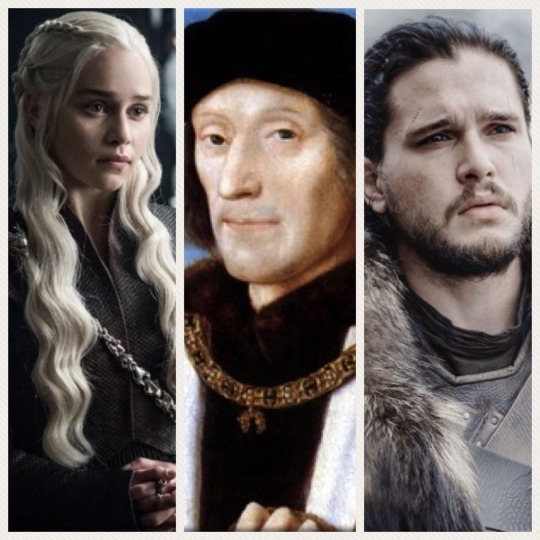
Jon Snow:
When Edward IV became the first Yorkist King in 1461, Jasper fled abroad and Castle Pembroke, along with the Earldom were given over to the Yorkist, William Herbert -who then took over guardianship of the 4 year old Henry and his mother. Henry lived in the Herbert household until 1469 (he was 12) when more York/Lancaster drama ensued and Henry VI reclaimed his throne.
Daenerys Targaryen:
At some point, fearing her son’s safety, Margaret sent Henry into exile with his uncle Jasper -where he remained, garnering French and Welsh support before returning to lay a claim to the throne. When Henry Tudor invaded England, his army consisted of French mercenaries and Welsh warriors – which would be considered a largely foreign group (foreign invaders -Dothraki and the Unsullied).
So, you see how in comparison to Henry’s early life, we could easily divide aspects of it between both Jon and Dany. Being raised by an uncle, being exiled for safety, garnering foreign support and returning to claim their “birthright”. It’s also important to note that with his father dying prior to his birth, Henry fought claims of illegitimacy (bastard) for most of his life.
A Dragon and a Prophecy
Henry also made some political capital out of his Welsh ancestry, attracting military support and safeguarding his army’s passage through Wales on his way to the Battle of Bosworth. He came from an old, established Anglesey family that claimed descent from Cadwaladr (a Welsh King depicted in legend, the last ancient British king), and on occasion Henry displayed that Welsh standard.
That Welsh standard Henry fought and conquered under? Well I’m glad you asked … The flag of Wales (Welsh: Baner Cymru or Y Ddraig Goch, meaning the red dragon) .

A red dragon! You don’t say? Where have we seen that before? Oh, right …the Targaryen house sigil.
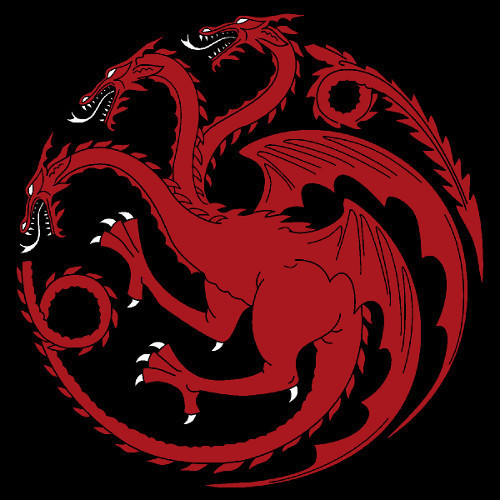
But Henry’s welsh dragon isn’t just ANY dragon, but -a dragon that’s attached to a prophecy: Y Mab Darogan.
From Wikipedia (again because I’m lazy):
Y Mab Darogan (pronounced [ə mɑːb darɔˈɡan] meaning “The Destined/Prophesised Son” or “Son of Destiny”) is a messianic figure of Welsh legend, destined to force the English out of Britain and reclaim it for its Celtic inhabitants. A number of figures have been called Y Mab Darogan in history (other titles include Y Gŵr Darogan and Y Daroganwr). An extensive corpus of medieval Welsh prophetic verse, beginning with Armes Prydain (10th century?), is centred on the figure of Y Mab Darogan.
A prince who was promised? Ya don’t say?!?!
Several historical figures have thought to have been this “Son of Destiny” -even King Arthur of Camelot. With poets and supporters labeling Henry the prophesied prince, it certainly didn’t hurt in strengthening his claim to the throne. Later, his reign over England was believed to be the prophecy fulfilled -a belief that he encouraged by naming his firstborn son Arthur.
Two Roses become One
As most of you know, Henry later wed Elizabeth of York. They were third cousins -both great-great grandchildren of John of Gaunt. The marriage unified the two warring houses and gave any of their future children strong claims to the throne. The unification of the houses of York and Lancaster by this marriage is symbolised by the Tudor Rose -a combination of the white rose of York and the red rose of Lancaster.

*Remember this, because we’ll come back to this later when I make my endgame predictions.
I would also like to present to you, the Tudor house Coat of Arms (under Henry VII and the first half of his son, Henry VIII’s reign):
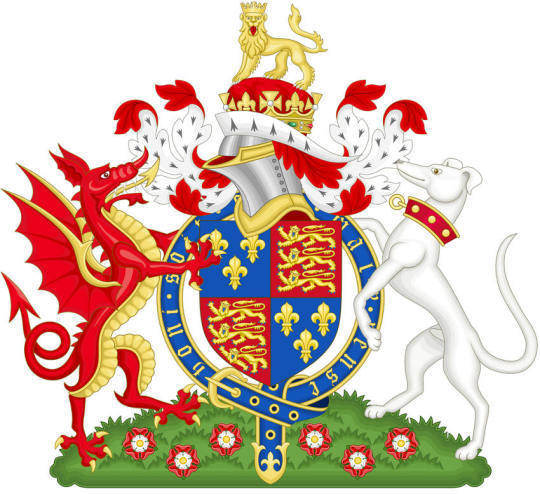
A red dragon, a white dog (wolf) and a golden lion sitting atop the crest, amid the Tudor roses.
As Alice (in Wonderland) would say: Curiouser and curiouser ….
The White Rose (of Winterfell?)

A red-headed beauty -Elizabeth of York was described as fair of hair and face. The eldest child, she had two younger brothers (known as the Princes in the Tower) who disappeared shortly after her father’s death -thought to be murdered by her uncle.
From Wikipedia (and you guessed it, because I’m lazy):
“The Princes in the Tower” is an expression frequently used to refer to Edward V, King of England and Richard of Shrewsbury, Duke of York. The two brothers were the only sons of Edward IV of England and Elizabeth Woodville surviving at the time of their father’s death in 1483. When they were 12 and 9 years old, respectively, they were lodged in the Tower of London by the man appointed to look after them, their uncle, the Lord Protector: Richard, Duke of Gloucester. This was supposedly in preparation for Edward’s forthcoming coronation as king. However, Richard took the throne for himself and the boys disappeared.
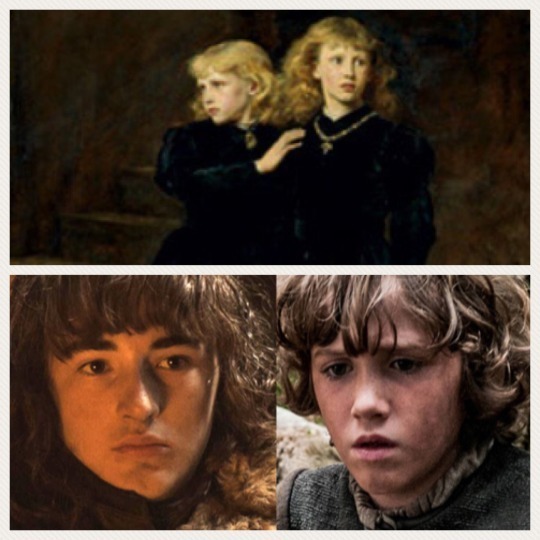
Compare this if you’d like, to Sansa’s brothers Bran and Rickon “disappearing” -first thought to be murdered by Theon, then Rickon actually being murdered, and Bran essentially dying as well, now that he’s the 3 eyed Raven. This may be a bit tin foilish, but Bran was also pushed from a Tower -which sent the whole chain of events in motion.
Despite being a political arrangement at first, the marriage between Henry and Elizabeth proved successful and both partners appear to have grown to love each other. Jon and Sansa have already proven to share a powerful loving bond rooted in trust.
But wait!
Aren’t the Starks (Yorks) supposed to be the good guys, and the Lannisters (Lancasters) the bad? I’m glad you asked, and I’ll hand you over to @thewesterwoman for that …
When it comes to the Wars of the Roses, one side - the Lancasters - has traditionally been presented in a far more positive light than the other - the Yorks. This is because the Tudor dynasty which ultimately emerged the victor of the war was descended in the male line from the Lancasters, making them the ‘winning’ side. As such, the vast majority of primary sources from after the war paint the Lancasters in a flattering light and the Yorks in a negative one, in an effort on the part of their writers to gain favor with the current reigning monarchs of England.
Today, this is especially noticeable in Shakespeare’s ‘history plays,’ several of which - Henry IV Part One, Henry IV Part Two, Henry IV Part Three, and Richard III - deal directly with the historical events of the Wars of the Roses. Shakespeare was writing during the reign of Elizabeth Tudor, and had an obvious motive for depicting her forebears as the heroes of the story that ultimately led to her rule. This is especially notable in Richard III, where the evil schemes of Richard of York lead England into chaos until the heroic Henry Tudor (a Lancastrian, and Elizabeth’s direct ancestor) finally emerges to defeat him and save the realm.
GRRM seems to have taken his fictional noble houses Stark and Lannister from the real-world Yorks and Lancasters, and they retain vestiges of the stereotypes of their historical counterparts. House Stark is strongly associated with tradtionally ‘evil’ motifs: ice, winter, death, and wolves (connoting the Big Bad Wolf of many fairytales). House Lannister, in contrast, has many ‘heroic’ connotations: warmth, sunlight, gold, and lions (which incidentally are on the royal coat of arms of England). From a distance, the Lannisters - with their wealth, beauty, and natural charisma - would seem like a natural fit for the protagonists of any story, while the Starks - known for their grim and gloomy dispositions and ominous House words - would seem like more natural antagonists.
But this is of course not the case. GRRM has both reversed the traditional historical narrative of the good Lancasters versus the evil Yorks, and the traditional motifs that we associate with good versus bad characters. In ASOIAF, the Starks are the heroes and the Lannisters are the villains, despite their respective surface appearances. This is both very interesting and very typical of GRRM, who loves to invert our expectations of fantasy narratives.
And now it’s time to put your tin foil hats on, because it’s endgame prediction time ….
So what does this all mean?
So if Jon and Dany are actually the two facets of Henry’s life prior to the crown -the exiled conqueror (Dany) and the “bastard” prince (Jon) raised by a Yorkist (Stark) -also his uncle, where does that leave Dany? Well, I’m pretty sure Dany will meet her death on the other side of the wall.
Let us return to Dany’s time spent in the House of the Undying -to simplify, we’ll use the show version. We’ll come back to her time in the throne room later, but first -remember when she stepped through what looked curiously like the gates to the other side of the wall -into the wintery beyond?

Here, she was reunited with her true love and husband, Khal Drogo and their son, Rhaego.
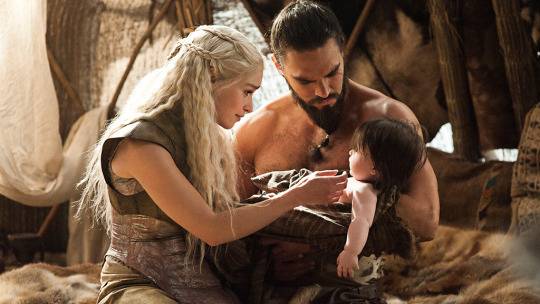
Here, she was reunited with her true love and husband, Khal Drogo and their son, Rhaego.
Perhaps this was a foreshadowing of sorts, that she will die in battle beyond the wall during the Long Night, and in death, be reunited with her son and husband -who wait for her in some form of purgatory, so they can all ride together into the Night Lands?
Drawing from the Henry Dany/Jon parallels, and if you’d like to get real tinfoil-y, we could look at Targcest as a way of melding these two halves of Henry into one. Maybe Dany perishes before the showdown with Cersei -leaving that war for Jon to be the parallel to Henry’s Battle of Bosworth -the battle that won him the crown by conquest -as to which he strengthened by then marrying Elizabeth of York.
*I’d like to make that very clear. He didn’t use his new wife to seal the deal, he used conquest (in defeating his rival) -he strengthened his throne (and future line of succession) in marrying EoY.
Returning back to Dany’s visions in The House of the Undying, she enters the throne room and it looks destroyed -although the throne still remains intact. Some people think it was ash falling through the broken ceiling -others snow. I’m going with the latter. Here’s why:
Dany approaches the throne, but does not touch it -instead she walks out the door which led her to the other side of the wall (to her family). She’s come to Westeros, but she will never be the queen. Instead, Jon will be the reluctant King -again thrust into a position of leadership that he doesn’t necessarily want, but will accept for the good of all. He will not be a King who conquered, but instead a King that was chosen.
Since Jon is both a Stark and a Targaryen, but his Targaryen lineage is what gives him a right to the Iron Throne -ironically, a Targaryen will once again rule Westeros. With Dany’s death, so dies the old House Targaryen that she represents, with Jon being the start of a new (and as @thewesterwoman points out -less incestuous) dynasty. This would again mirror the fate of House Plantagenet.
But will he rule as a Targaryen? Or a Stark? Maybe neither?
Perhaps he will rule as a Snow -which considering the connotations, and how being a bastard plagued him his entire life, it would certainly be rather poetic. The Snow falling in the throne room could be a foreshadowing of this. The Targaryen structure is destroyed, but the throne that Targaryen and Lannisters have sat on, is intact.
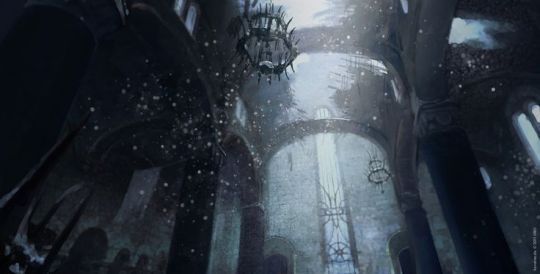
And remember this? The blending of the Lancaster and York roses into the Tudor rose?
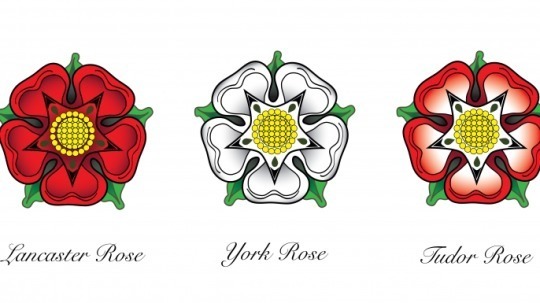
This also leads me to believe that Jon might start a new house entirely, and create his own house sigil -combining the Targaryen and Starks somehow, but allowing BOTH original houses to die off -much like both the Lancasters and Yorks, with no male heirs left to carry on the names. In the books, snow is a big theme in a lot of Sansa’s arc -especially the time she spends as Alayne in the Vale. Many have already drawn these parallels to Jon.
There Must Always be a Stark in Winterfell
(Inspired by the ask I sent thewesterwoman)

Bran has made it pretty clear that he is NOT the Lord of Winterfell. Bran technically isn’t even Bran anymore. *Think of Elizabeth of Yorks two brothers (the princes in the tower). If Arya marries, she will take her husband’s name -same with Sansa. So, if Jon doesn’t take the Stark name, the Stark name perishes, too.
Consider if you will, that Winterfell falls in the Long Night. It was built by Brandon Stark (aka: Bran the builder), one of the “First Men”, as well as the founder of House Stark. He also is said to have built the Wall -“raised it with the aid of Giants”, according to legend. Ironically, the Night King is known to be one of the First Men, too. Supposedly, Bran Stark is in the Winterfell crypts, although some have speculated that he’s actually the NK.
What if there’s something “magical” behind Winterfell and it’s crypts? When Bran asked undead Benjen to come with them to the other side of the wall, he said he couldn’t, as there was magic carved into the foundation of the Wall, and as long as it stood, he could not pass. Maybe there’s something magical connected to Winterfell and the phrase “there must always be a Stark in Winterfell” and, that it’s all somehow connected to the Night King.
If the Night King is defeated once and for all, and Winterfell falls, there’s no longer a “need” for a Stark to be there -giving credence to the theory of Jon starting a new house entirely.
With the Starks being the “good guys” and the story mostly framed around them, Jon and Sansa as Ned/Cat 2.0 yet, the end of House Stark sounds pretty bittersweet to me.
Of course, this is all just speculation …
War of the Roses was only one of many things that GRRM drew inspiration from.
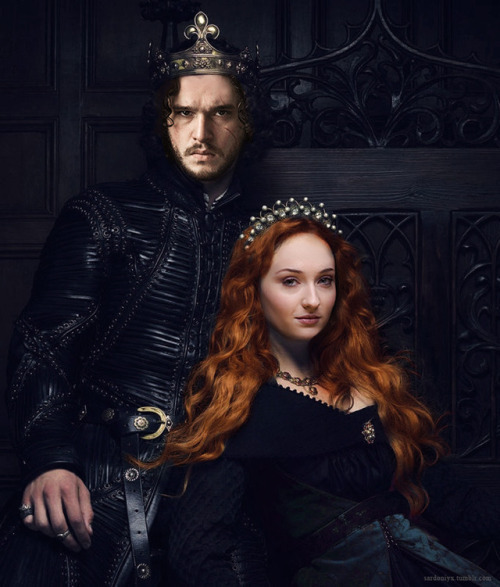
*credit to @sardoniyx for this AMAZING manip work!*
#got meta#wars of the roses#jonsa meta#got predictions#got speculation#jonsa is endgame#wars of the roses parallels#asoiaf#asoiaf meta#jonsa#jon x sansa
1K notes
·
View notes
Text
EVERY QUIVER OF HIS BEATING HEART .....
__________________________________________________
Am I the current king of England ... or are we here to see the queen?
Just like Mycroft is strongly connected with the term 'QUEEN', Sherlock is more than once connected to the 'KING'. In a way, both ot them represent 'ENGLAND/LONDON' with Mycroft as the Government, Sherlock as the countly, the city, the body ... and Baker Street 221b as the metaphorical heart of it. The voice given to that heart seems to be Mrs. Hudson but also John.
Mrs Hudson leave Baker Street? England would fall.
Once in a while Mycroft, in his function as government (brain), turns up - spying, controlling, offering dubious cases. Then John Watson moves in and 'takes the room upstairs'. John just came back from the East - from the battlefields of Afghanistan - scarred and badly wounded. Walking at the side of Sherlock Holmes, he sets his feet now onto a different kind of 'battlefield' ... as the brain tells him.
Most people blunder round this city, and all they see are streets and shops and cars. When you walk with Sherlock Holmes, you see the battlefield. You’ve seen it already, haven’t you?
On another day in the story Sherlock comes back from the East as well - from imprisonment and torture in Serbia - scarred and wounded himself. Most urgently summoned by his brain (Mycroft) because 'there's going to be a terror strike on London - a big one'. (terrorists=emotions)
Just put me back in London. I need to get to know the place again, breathe it in – feel every quiver of its beating heart.

Sherlock clearly enjoys HIS big city ... London. Seems he is indeed a 'city boy' just like his mirror Edward Van Coon in TBB. It doesn't seem likely that Sherlock could bear to live somewhere else for a longer period of time.
London. It’s like a great cesspool into which all kinds of criminals, agents and drifters are irresistibly drained.

And it looks like John Watson has very similar feelings where London is concerned ...
I returned to England with my health irretrievably ruined and my future bleak. Under such circumstances, I naturally gravitated to London, that great cesspool into which all the loungers and idlers of the Empire are drained.
But of course, this is from TAB and therefore in Sherlock's own head. What goes on in his head though? Is he considering how John might have felt upon returning from the war in Afghanistan .... or is he reliving his own return from his own 'war' back in TEH?
And then - when Sherlock, John and Mycroft encounter the 'final problem' - all three of them decide to be soldiers that day. Even Mycroft .....
JOHN: Today we have to be soldiers, Mycroft, soldiers ...
SHERLOCK: Soldiers today.
SHERLOCK: Soldiers?
JOHN: Soldiers.
MYCROFT: Today, we are soldiers.
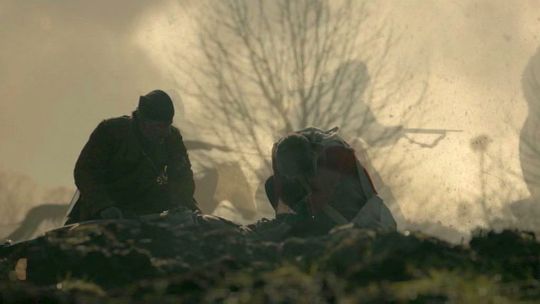
Playing once more with a methaphorical reading of Sherlock BBC where England/London represents Sherlock's body. It's part of a thread I decided to call 'Sherlock deducing Sherlock'. And of course, this is just one of several threads running through this story ... side by side .... every single one telling a different story.
More under the cut ... mostly vexillology and history but also lions and dragons .... beware ..... :))))
England/London ... the body ... Sherlock
The government ... the brain ... Mycroft
221b Baker Street ... the heart ... John
How the flag of England came into being ... the Union Jack
The flag combines aspects of three older national flags. The first version dates back to 1606 when James VI of Scotland united the crowns of Engalnd, Scotland and Ireland in a personal union, although the three kingdoms remained separate states. (X)

the white saltire on blue background of St Andrew to represent Scotland
the red saltire on white background of St Patrick to represent Ireland
the red cross on white background of St George for the Kingdom of England,
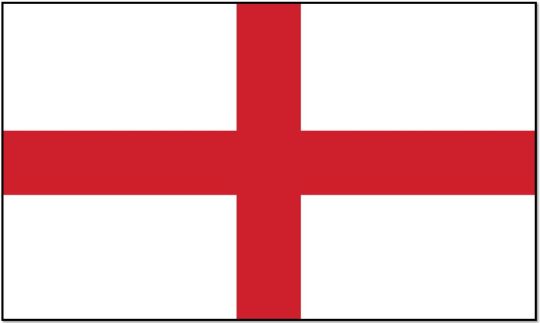
Saint George's cross
Its first documented use was as the ensign of the Republic of Genoa. Later it was used by cursaders. The cross ceased to be a symbol directly associated with the "taking of the cross", the resolve to fight in a crusade, after the failure of the crusades in the 14th century.
The St. George's flag, was adopted by England and the City of London in 1190 for their ships entering the Mediterranean to benefit from the protection of the Genoese fleet.
From 1348 and throughout the 15th century, the Saint George's Cross was shown in the hoist of the Royal Standards of the Plantagenet kings of England. The combined flag form 1606 was initially for maritime display, later restricted to the King's ships.
The symbol has since been adopted as the emblem of several countries and cities which have or had Saint George as a patron saint, notably the Republic of Genoa, the Duchy of Milan, England, Wales and Georgia in the Caucasus Mountains of Eastern Europe. (X)
Georgia and Tiblisi
Regarding Sherlock BBC several important things happen in this country. In fact, Georgia is (though just for some short scenes) more heavily featured than any other country in this story appart from Great Britain itself.
That's Tiblisi. Isn't it beautiful?

The legendary Black Pearl of the Borgias is stolen from a secret vault
The ambassador and her husband are taken hostage and killed
AGRA - the group of 'super-agents' - sent in to free the hostages - are deceived and get destroyed
One ot the important memory sticks is hidden in a Thatcher plaster bust manufactured in a workshop inside (?) or at least very close to the ambassy
A batch of those busts - including exactly the one with the hidden memory stick - is supplied to London.
The creators of Sherlock BBC could have chosen any country in the world for any of the events mentioned above. Why did they go for Georgia? Well, maybe .....
... the name, the flag, the coat of arms?
The flag of Georgia is also known as the Five Cross Flag. Originally a banner of the medieval Kingdom of Georgia, it was brought back during periods of Georgias national revival and served as one of the most recognizable symbols of the bloodless Rose Revolution. Since 2004 it is the official flag of Georgia.

This Five Cross Flag of Georgia is a red-on-white version of the Jerusalem Cross. The four small crosses are officially described as 'Bolnisi Crosses', even though they are only slightly 'pattée' .... meaning that the arms are narrow at the center, often flared in a curve or straight line shape, to be broader at the perimeter ... like the Maltese cross.
The coat of arms of the Kingdom of Jerusalem were originally displayed in gold on silver. But the colors could be changed. Usually metal on metal, brakes the heraldic Rule of Tincture. It was justified in this case by the fact that Jerusalem was so holy, it was above ordinary rules.
The five-fold cross symbolizes either the Five Wounds of Christ, Christ and the four evangelists or Christ and the four quarters of the world.
If England represents Sherlock's body, the red cross of Saint George and the name of the saint himself connect Sherlock very closely to Georgia. And the Five Cross Flag of Georgia constitutes a connection to Jerusalem and Christ. Another Christ reference in this story it seems ....

Georgia's coat of arms features an image of Saint George, riding a horse trampling upon a dragon, whose head is pierced by the saint's spear. Two lions are supporting the shield, which is surmounted with the royal crown of Georgia. The motto below the shield reads "Strength is in Unity"
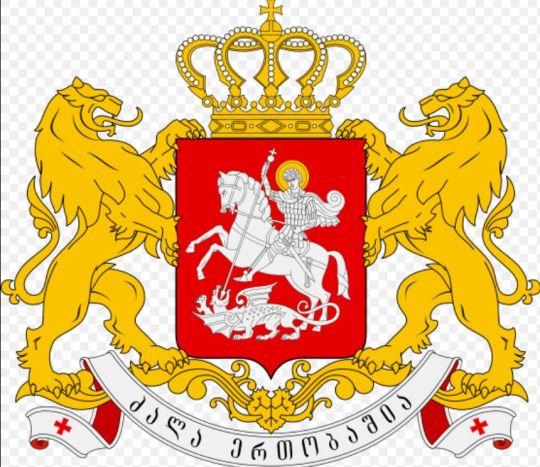
Saint George's monument in front of the City Council in Tiblisi, Georgia

The Tiblisi incident
When AGRA are storming the embassy in Tiblisi the 'Five Cross Flag' can be seen very prominently in the background .... it looks like it has been blown into the open window by a draft of air .... but the weather must have changed ... because despite the still open window and all the action in the room, neither flag nor curtains are moving one bit throughout the whole scene.
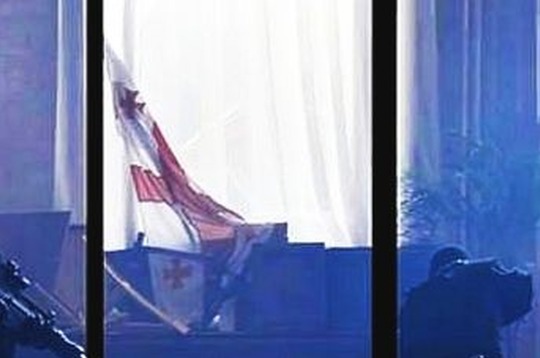
Two life-size statues of lions are dramatically flanking the centre of the room ......

Saint George and the dragon
According to legend, Saint George was a roman soldier of greek origin and officer in the guard of Roman empereor Diocletian. He is one of the most prominent military saints and immortalised in the myth of Saint George and the Dragon. While the veneration of Saint George as a soldier saint goes back to the 7th century at least, the earliest known surviving narrative of the dragon episode is an 11th-century Georgian text.
The town had a small lake with a plague-bearing dragon living in it and poisoning the countryside. To appease the dragon, the people fed it two sheep every day. When they ran out of sheep they started feeding it their children, chosen by lottery. One time the lot fell on the king's daughter. The king, in his grief, told the people they could have all his gold and silver and half of his kingdom if his daughter were spared; the people refused. The daughter was sent out to the lake, dressed as a bride, to be fed to the dragon.
Saint George by chance rode past the lake. The princess tried to send him away, but he vowed to remain. The dragon emerged from the lake while they were conversing. Saint George charged it on horseback, seriously wounding it with his lance. He then called to the princess to throw him her girdle, and he put it around the dragon's neck. When she did so, the dragon followed the girl like a meek beast on a leash.
Of course, the story ends like almost any dragon story does .... despite 'meek and on a leash' the dragon has to die.
A dragon living in water, a game of chance, a damsel in dirstress dressed as bride, a knight making a vow, a dragon on a leash .... well, well .... if this doesn't sound familiar .....

The work of an unknown artist: Saint George and the dragon from De Grey Hours (a medieval Book of Hours probably written for the De Grey family of Ruthin c.1390) National Library of Wales
Once more unto the breach, dear friends ....
"Once more unto the breach, dear friends ... once more!
Or close the wall up ... with our English dead!
... set the teeth and stretch the nostril wide.
Hold hard the breath and bend up every spirit ... to his full height!
On, on, you noblest English ... whose blood is fet from fathers of war-proof!
And you, good yeoman, whose limbs were made in England, show us here the mettle of your pasture!
... which I doubt not, for there is none of you so mean and base ... that hath not noble lustre in your eyes!
I see you stand like greyhounds in the slips, straining upon the start!
The game’s afoot.”
In The Lying Detective Sherlock quotes William Shakespeare's HENRY V, Act 3, Scene1. Among other parts, the last two lines of the monologue are missing:
Follow your spirit: and upon this charge, cry ....
God for Harry! England and Saint George!
Saint George is the patron saint of England and the protector of the royal family. His cross forms the national flag, and features within the Union Flag of the United Kingdom.
Again - if England indeed represents Sherlock's body, the red cross of Saint George and the saint himself connect Sherlock very closely to Georgia, Tiblisi ... AND the hostage incident in the embassy as well.
Is this maybe a supressed and coded memory? Georgia representing England at some time in the past .... in Sherlock's past? Is 'Georgia' not a different country but a different time? Dead people in Sherlock's past? Did he triy/wish to save them, but failed? Because he was just a child at that time? And was there really some foul play involved? Has Sherlock told himself another different/better story, to 'get rid' of the painful memory of the actual event?
But this isn't the end of this post yet .... there are still more connections ....
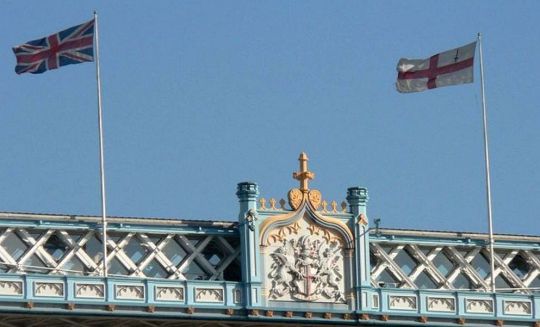
The Royal Arms of England
It was first adopted in a fixed form round 1200 by the Plantagenet kings and depicts three identical gold lions with blue tongues and claws, walking past but facing the observer, arranged in a column on a red background.
This design has not been altered since then. Over the centuries it has been variously combined with the signs and symbols of other kings and royal houses, according to dynastic and political changes occuring in England.
The present coat of arms of the United Kingdom used by Queen Elizabeth II includes a harp for Ireland and for Scotland a rampant lion surrounded by a flowered border. The dexter supporter is a crowned English lion; the sinister supporter, a Scottish unicorn. The Motto 'Dieu et mon droit' translates to 'God and my right' (X X)
(dexter & sinister = right or left from the POV of the bearer of the shield)
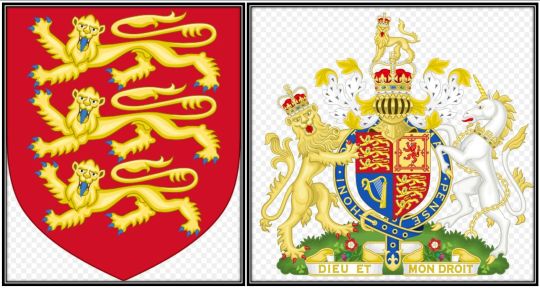
During the promotion for S4 the Union Jack and the crowned English lion made their appearance together with a mysterious question mark .... and the term 'sinister' showed up two times as well in tweets.
Related posts: The mirrored question mark Question mark and eyes Lions Sinister & orphans Mark's 'sinister' tweets The sinister hand

The flag of the City of London
It is based on the flag of England but represets only the historical City of London .... not Greater London. The sword symbolises the sword that beheaded Saint Paul who is the patron saint of the city. (X)
(A sword is definitely no blunt instrument but a sharp weapon which can also be 'wielded with precision and without remorse' .... like a scalpel ... :))))
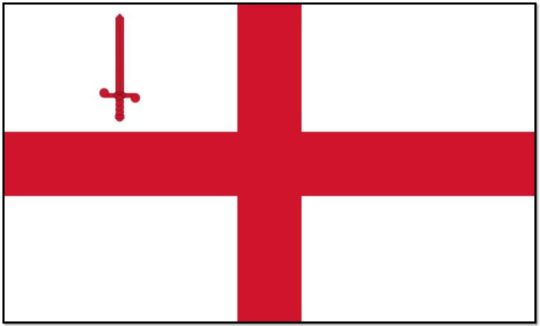
Coat of arms of the City of London
It consists of a silver shield bearing a red cross with a red upright sword in the first quarter, combining the emblems of the patron saints of England and London: the Cross of St George with the symbol of the martyrdom of Saint Paul.
Sherlock looking out over London ... Saint Paul's Cathedral to his right.

The crest depicts a dragon's left (sinister) wing bearing also the cross of St George, borne upon a peer's helmet. (X)
(A helmet is part of a knights armour, worn to shield the head. Broadly speaking, a helmet is rather similar to a mask ... hiding/covering head and face of a person. No one is able to recognize who's relly behind such an armour. Could be anyone. It's rather similar to ... 'putting on a facade'. Just saying .... :))))

Two silver dragons bearing red crosses upon their wings are supporting the arms. The latin motto of the City is Domine dirige nos, which translates to "Lord, direct (guide) us".
DIMMOCK: I go where you point me.
SHERLOCK (walking away): Exactly.
(Sorry, couldn't resist this bit of dialoge from The Blind Banker. It's just too good! And John's words from HLV 'Your way. Always your way' run exactly in the same vein as well. :))))
There be dragons .....
In the episode The Blind Banker (S1) the Yellow Dragon Circus comes to London to retrieve something that was stolen. Not the Black Pearl of the Borgias, no .... but something almost equally small and probably equally valuable ... a jade hairpin in the shape of a snake. Or is it a tiny Chinese baby dragon? Anyway, snake or dragon, both are reptiles. And the showdown of that episode takes place at a place called ... 'Dragon Den, Black Tramway'
And the dragon references continue .....
JIM: Sir Boast-a-lot was the bravest and cleverest knight at the Round Table, but soon the other knights began to grow tired of his stories about how brave he was and how many dragons he’d slain ...
MYCROFT: He (Magnusson) is a necessary evil – not a dragon for you to slay.
SHERLOCK: A dragon slayer. Is that what you think of me?
MYCROFT: No. It’s what you think of yourself.
MYCROFT: ... but on balance you have more utility closer to home.
SHERLOCK: Utility? How do I have utility?
MYCROFT: “Here be dragons.”
MARY: Sherlock the dragon slayer.
Dragon or dragon slayer ... that's the question
Or could it be both? Is Sherlock not only the dragon slayer but also the dragon?
"... in your case, solitary confinement is locking you up with your worst enemy"
Sherlock at war with himself? Sherlock fighting parts of himself? The dragon fighting his inner dragon? And even his brain tells him 'this is a war we MUST lose'. Could Sherlock really be that dragon himself?
Well, it is said that dragons are breathing fire .... wherever there is fire there is smoke as well ...... :))))))



All pics not Sherlock BBC are from Wikipedia and related to the sites I used for gathering information. Thanks @callie-ariane for the scripts.
I leave you to your own deductions.
November, 2017
@gosherlocked @loveismyrevolution @sagestreet @sherlockshadow @raggedyblue @monikakrasnorada @possiblyimbiassed @sarahthecoat @darlingtonsubstitution @devoursjohnlock @tjlcisthenewsexy @kateis-cakeis @tendergingergirl
91 notes
·
View notes
Text
also i saw people get pissy over “why are you scared of whales?” “because dragons live in wales” because they thought it was insinuating that 2d couldn’t tell the difference
i’m welsh and i can assure you that this is one of the most fucking common jokes ever. mixing whales up with wales is like... a deliberate joke. also 2d’s completely right. dragons do live here. that’s why we have one on our flag. i have at least 3 dragons in my back garden.
15 notes
·
View notes
Text
Beyond a 90-minute nation
On the verge of the Euros, how can we build an inclusive Englishness outside of the stadium - my part of this new report by British Future and the Centre for English Identity and Politics.
Although much progress has been made, English identity has lagged behind the inclusivity of Britishness. As a national identity, rather than a community identity, Englishness must be open to everyone making their lives in England. There are real dangers if we make progress too slowly. Sport has had to carry too much of the weight of projecting an inclusive Englishness. It is now time for many other organisations across civic society, politics and the media to step up and share this national responsibility. This chapter examines the development of Englishness as an inclusive national identity, and then looks forward to suggest some principles that should underlie efforts to articulate Englishness in a diverse nation.
England as a nation
England is a nation with well-defined boundaries. Since UK devolution it has very largely had its own separate domestic policy and legislation across education at all levels, in health and social care, in the provision of water, and in much of transport, agriculture and the environment. It has no national democracy nor machinery of government — that’s for another discussion — but its politics and governance are distinct from the other nations of the union. England is not a ‘cultural idea’, but a political and governmental nation.
English and British identities predominate here. Four out of five say they are strongly English and, with much overlap, a similar number are strongly British. Most hold these identities proudly. There is a slight tilt towards Englishness over Britishness, with around 35–40% saying they are equally English and British; 25%-30% ‘more English than British’; and 20–25% ‘more British than English’.
No one should feel they ‘ought’ to have a particular identity; nor that a particular identity is ‘not for them’. Major public policy debates should not be distorted by any sense that national identities are proxies for other divisions. In building strong and inclusive local communities in England, English and British must available as shared national identities, not stand-ins for communitarian or ethnic identities.
There has been much positive progress but there is no room for complacency. In the coming years England may well become more fragmented by geography, income and education. Major cities are rapidly becoming ever more diverse and the chosen home of graduates. Other parts of England are changing more slowly. A nation — or town — in which these divisions were reflected in different national identities would not be a happy or cohesive place.
It is true that over the past twenty years the extent to which an individual identifies as English or British has become associated with different views about the governance of England and Britain, and England’s relationship with the Union and the EU. But debates about England’s governance, the future of the union and the UK’s relationship with Europe and the EU will rage around us for some time. Whatever our views on these questions, a healthy political nation needs both of England’s national identities to be open to all.
The current state of play
Britishness is more widely adopted by ethnic minority residents than Englishness, but the difference is not as stark as some suggest. Around a third of ethnic minority residents identify strongly as English and are proud to do so. That’s half the rate of the white majority but not an insignificant number. It demonstrates the potential for Englishness to become a much more inclusive identity. That potential is underlined by British Future’s most recent polling which asked BAME respondents about their ‘sense of belonging’ to both Britain and England: the responses at 30% ‘strongly’ and 35% ‘somewhat‘ were identical.
In recent years the majority population has become dramatically more open to a diverse English identity. Over the 7 years from 2012–2109, the number saying that English was a white identity fell from one in five to one in ten with the fall being most marked amongst older voters .
In 2021, a significant minority of visible ethnic minorities already identify as English. The majority population, including those who emphasise their English identity, are more open to an inclusive English identity than ever before. Before looking at how to make Englishness more open to ethnic minorities, it’s important to understand why Britishness is currently the more inclusive identity.
Englishness, Britishness and multiculturalism
A common myth claims that the British Empire’s cosmopolitanism makes Britishness the more natural identity for minorities originating from former colonies. But as late as the 1980s, British identity was widely seen in England as inherently racist, colonialist and imperialist. Today’s more inclusive Britishness was forged by the promotion of British multiculturalism by grassroots campaigns with endorsement from the state and civic society. British multiculturalism used a shared legal citizenship to demand equal respect and treatment. Englishness was neglected entirely and the surprise might be that it has changed as much as it has. (In Scotland and Wales, by contrast, political and civic society focused on making Scottish and Welsh identities more inclusive rather than British identity).
In 2018 85% of white respondents felt ‘strongly’ English compared with 45% of ethnic minority respondents. 84% of white residents were strongly British compared with 73% of ethnic minority residents. 61% of white residents were ‘proud’ to be English, and 32% of ethnic minority residents (Less than 10% of either group would actually be embarrassed to be English).
A second challenge is that those who staff England’s most influential institutions such as the civil service, academia, the media, NGOs and cultural organisations are significantly more likely to emphasise a British rather than an English identity .
Organisations that could be taking the lead in promoting an inclusive Englishness often shy away from doing so. At worst they may perpetuate the worst and most out-dated stereotypes of English identity.
Looking to the future
The lesson of Britishness (and Scottish and Welshness) is that national identities can be consciously refashioned as inclusive, but that this will require the commitment of every organisation and institution that engages with England and its people. This includes non-government and civic society groups, arts and cultural organisations, the media, political parties, sporting organisations, and the state at local and national levels.
I suggest seven principles to guide this work:
1. Acknowledge the English dimension to our work.
Many organisations that engage with England often avoid naming it, using ‘ the country’ or ‘Britain’ or even the UK when talking only about England. (Nearly all political parties do this, for example). Some organisations describe themselves as ‘UK’ even when they have separate Welsh and Scottish branches. Making England invisible as a geographical, policy and organisational nation reinforces the idea that English identity is a cultural not a national identity.
2. Ensure that any visual representation of England and its people are fully representative of England’s population
A 2018 survey found that many St George’s Day events promoted by local authorities and even state-sponsored charities such as English heritage used overwhelmingly white images of activities. This not only reinforces the idea that Englishness is an ethnic communitarian identity but excludes the large number of non-white people who already identify strongly and proudly as English.
3. Sharing our stories in today’s England
At the heart of any national identity are the stories we share about who we are, how we came to be here and what we value in common. Englishness must be open to all who are making their lives here. Our shared stories of England need to include the stories of those people whose families may have moved here in the relatively recent past and those (some of whom will have their own migrant heritage) who have lived in England much longer. It is easy to underestimate the power of actually taking the time to share our stories, whether at work, in local communities or in national organisations.
4. Avoid deliberately or inadvertently promoting or reinforcing inaccurate or out-dated representations of English identity
It is commonplace to find English identity openly associated in the media and social media with racism, xenophobia, far right politics, nationalist politics, little Englanders and the like. Cultural representations of English identity often promote similar conceptions. These come not just from fringe sources but mainstream politicians, prominent commentators and powerful cultural influencers. This unfair misrepresentation makes English identifiers reluctant to say so and, of course, makes Englishness unattractive to anyone who would find such values understandably threatening. Exploration of historic and current manifestations of Englishness is, of course, legitimate and important, but this should be done fairly and accurately.
5. Find opportunities to celebrate English identity
St George’s Day is one opportunity to acknowledge and celebrate English identity (provided it is done inclusively). Southampton’s St George’s Day produced discussion material linked to the PHSE curriculum asking ‘what modern dragons need slaying’, worked with the local newspaper to run a St George’s community award whose nominees came from all sections of the community, and offered small grants to encourage community organisations to run St George’s Day events. Sporting events provide many other opportunities to ensure that the flag belongs to all of England. Organisations that serve England might look for an activity or event that particularly marks that relationship. Englishness should not be restricted to those born here but being born in England is overwhelmingly accepted as making someone English. This ‘birth-right’ of being born English may be woven into all celebratory activities.
6. Join the local with the national
Work to promote cohesive communities often focuses on local belonging and identity, understanding rightly than different communities may share a local allegiance even where national identities differ. But there are good opportunities to link the two. A distinct feature of Englishness is that it is usually also associated with a strong local identity. Being ‘from here’ can open the door to English identity to many. And the new British Future polling shows that ethnic minority respondents are much more likely to agree that English identity is open to them in areas where different races get along well together and to disagree in areas where they do not. Promoting an inclusive English identity can be a positive part of promoting a cohesive local identity.
7. An inclusive Englishness benefits us all
For obvious reasons, the focus of inclusivity is on ensuring that people in England from an ethnic minority background feel that Englishness is fully open to them. But the British Future data also shows that a significant minority of white residents are not certain that the St George cross or St George’s Day are fully open. Some may feel they represent a reactionary Englishness that they reject. By building an inclusive English identity we can ensure that Englishness, including its symbols and celebrations, are fully shared.
8. Do not be afraid of engaging with English identity!
Because the staffing and leadership of many NGOs, arts and cultural institutions, academia and the media, are much less likely to identify as English than the general population, these organisations often lack confidence in engaging with English identity. Many internalise all the worst misconceptions of Englishness and fear that to associate with it is to endorse those imagined values. This challenge needs to be recognised and tackled. As more organisations do so, and share good practice, the collective confidence of these crucial ‘cultural influencers’ will grow.
What next for Englishness?
The continued development of an inclusive English identity, open to all, is essential to averting future identity-based divisions. It is a shared task that cannot be left to one organisation or one area of activity. Every organisation than engages with England has a role to play and, while some will take to this more easily than others, our ability to do so will grow as we work together
0 notes
Text
Red-dragon flags greet Prince Harry and fiancée Meghan Markle in Wales
CARDIFF (Reuters) – Britain’s Prince Harry and his American fiancée Meghan Markle visited Wales on Thursday on their third official joint appearance since announcing their engagement last November.
The couple have attracted huge attention since announcing they were getting married, and as with their previous appearances, hundreds of people greeted them in Cardiff, waving Welsh flags emblazoned with red dragons.
“Amazing, it was a dream of mine come true,” said Carol Powell, 39.
Harry, 33, and Markle 36 heard performances from musicians and poets at Cardiff Castle before making their way to a community center to see how sport is helping engage disadvantaged young people and promote their social development.
Harry, fifth-in-line to the throne, and actress Markle, best known for the TV legal drama “Suits”, are due to marry in May at Queen Elizabeth’s Windsor Castle home to the west of London.
“They were lovely and they were shaking hands with everyone and Harry was just having a chat with everyone so it was really nice,” Angharad Akideinde, 18, told Reuters.
“Because they are the younger generation they are more modern. It’s like the way they communicate with us as well. It is different to how the older ones would because they are more traditional I guess.”
Markle, who intends to become a British citizen, said after their engagement was announced that she was looking forward to getting to know her future homeland.
Reporting by Alex Fraser; editing by Michael Holden
Our Standards:The Thomson Reuters Trust Principles.
The post Red-dragon flags greet Prince Harry and fiancée Meghan Markle in Wales appeared first on Sports News, Transfers, Scores | Watch Live Sport.
0 notes